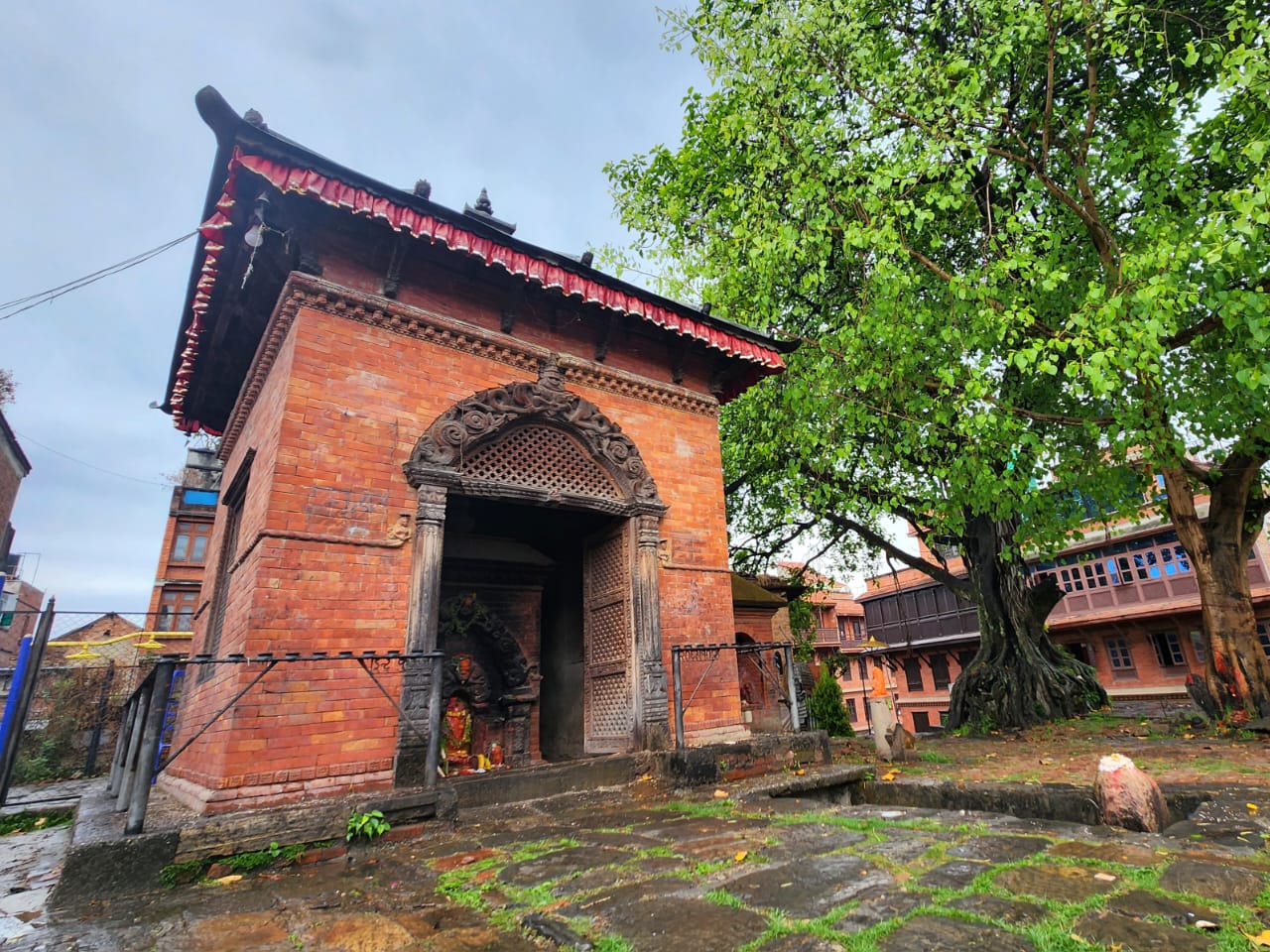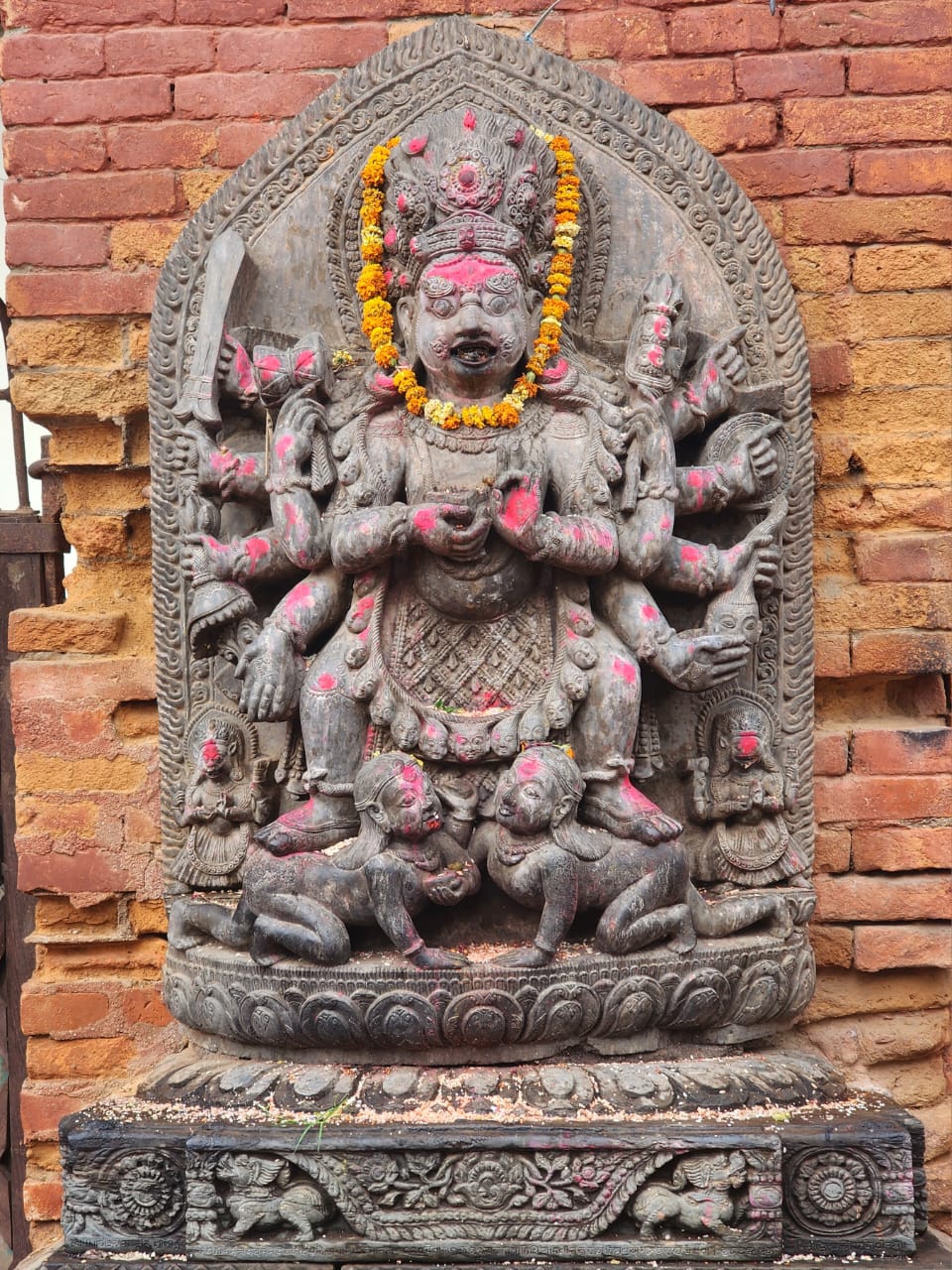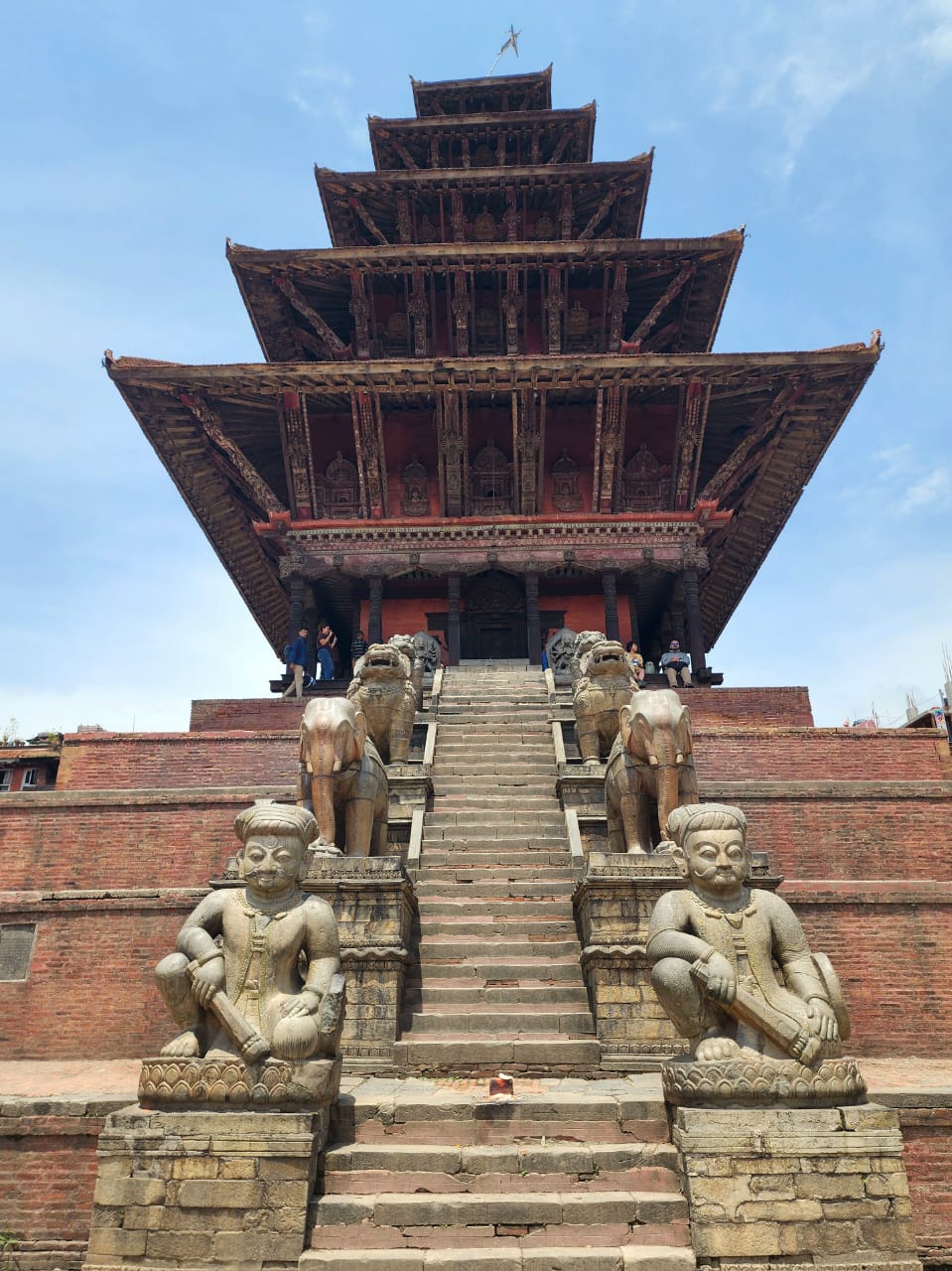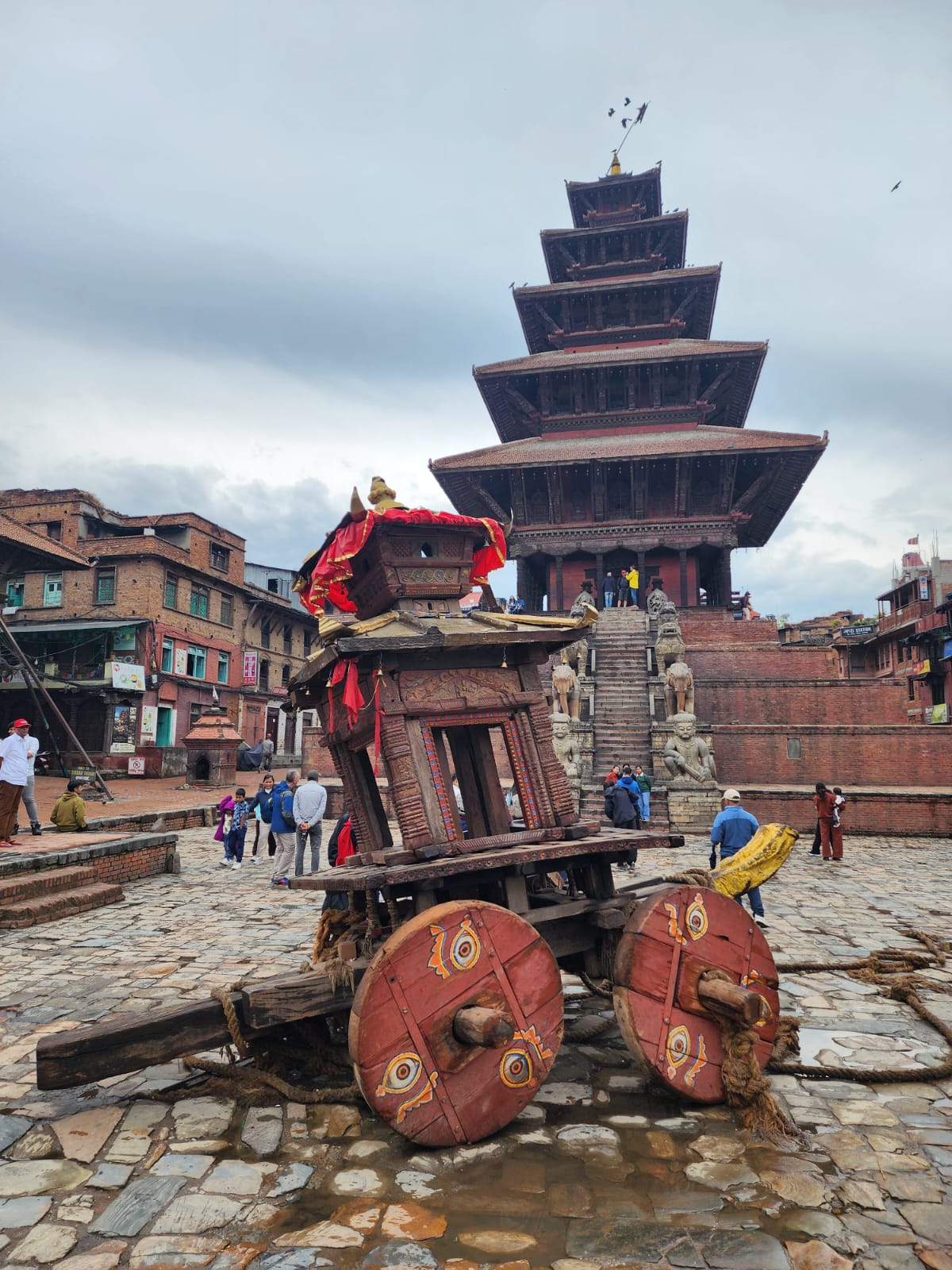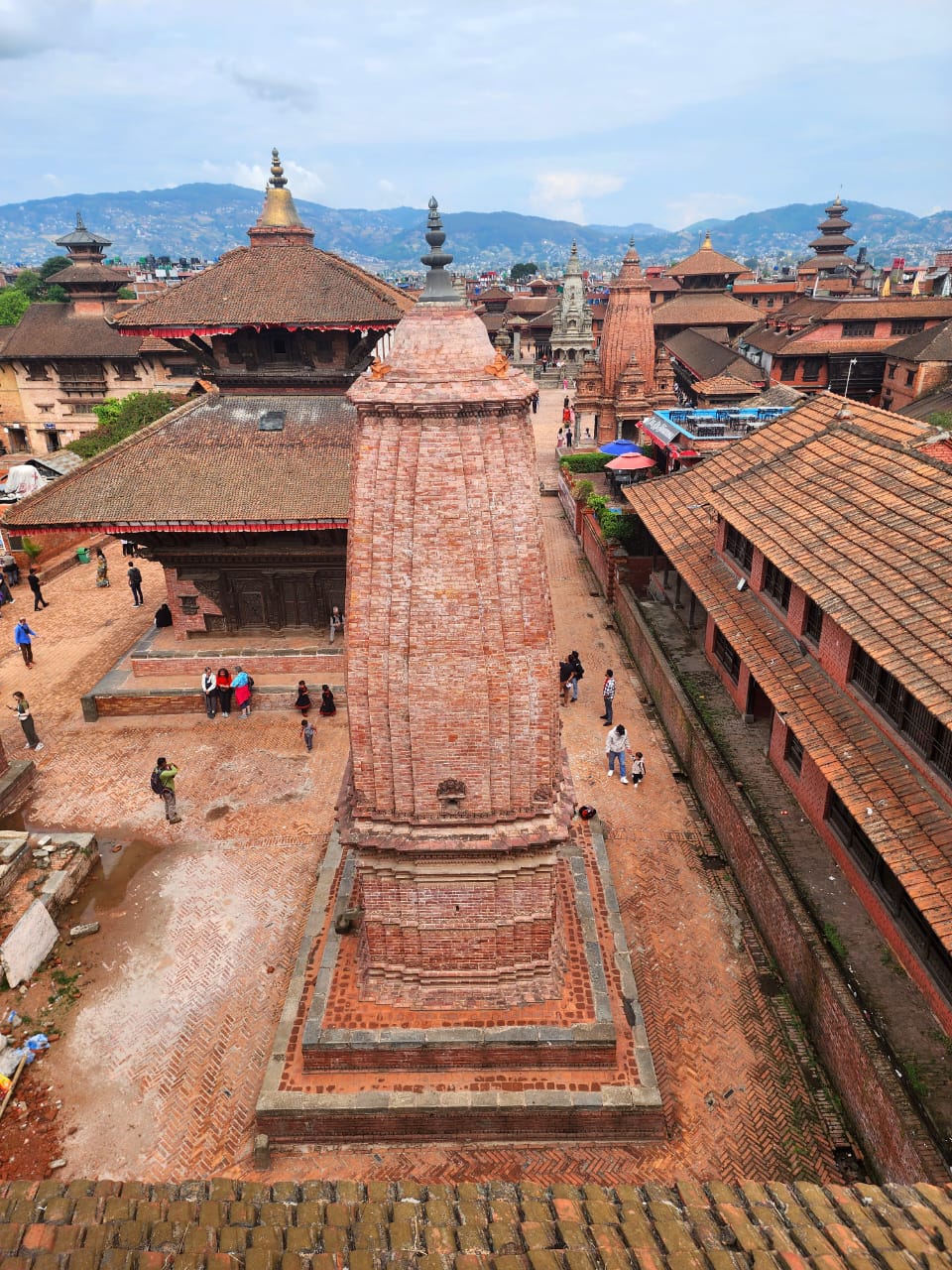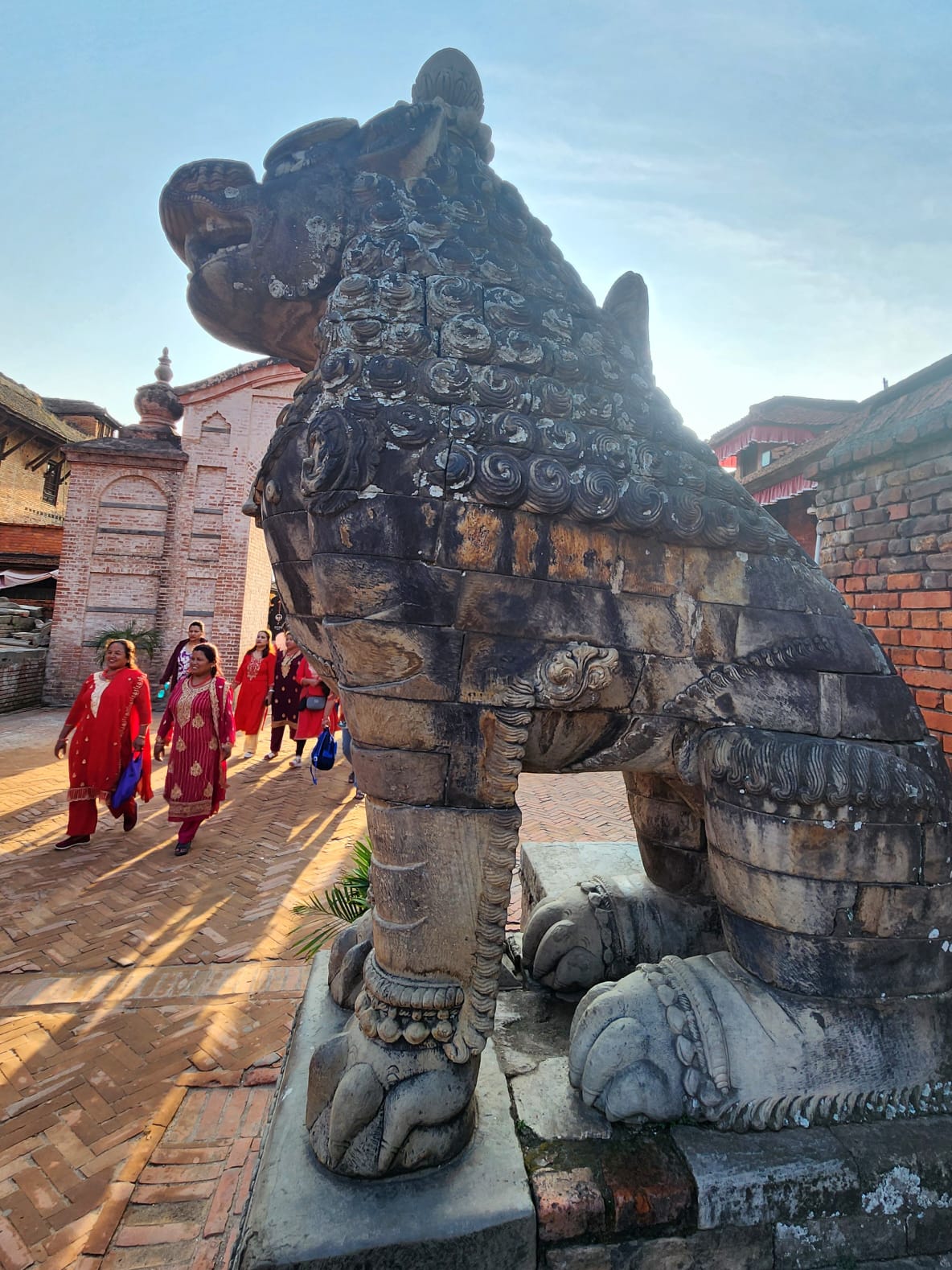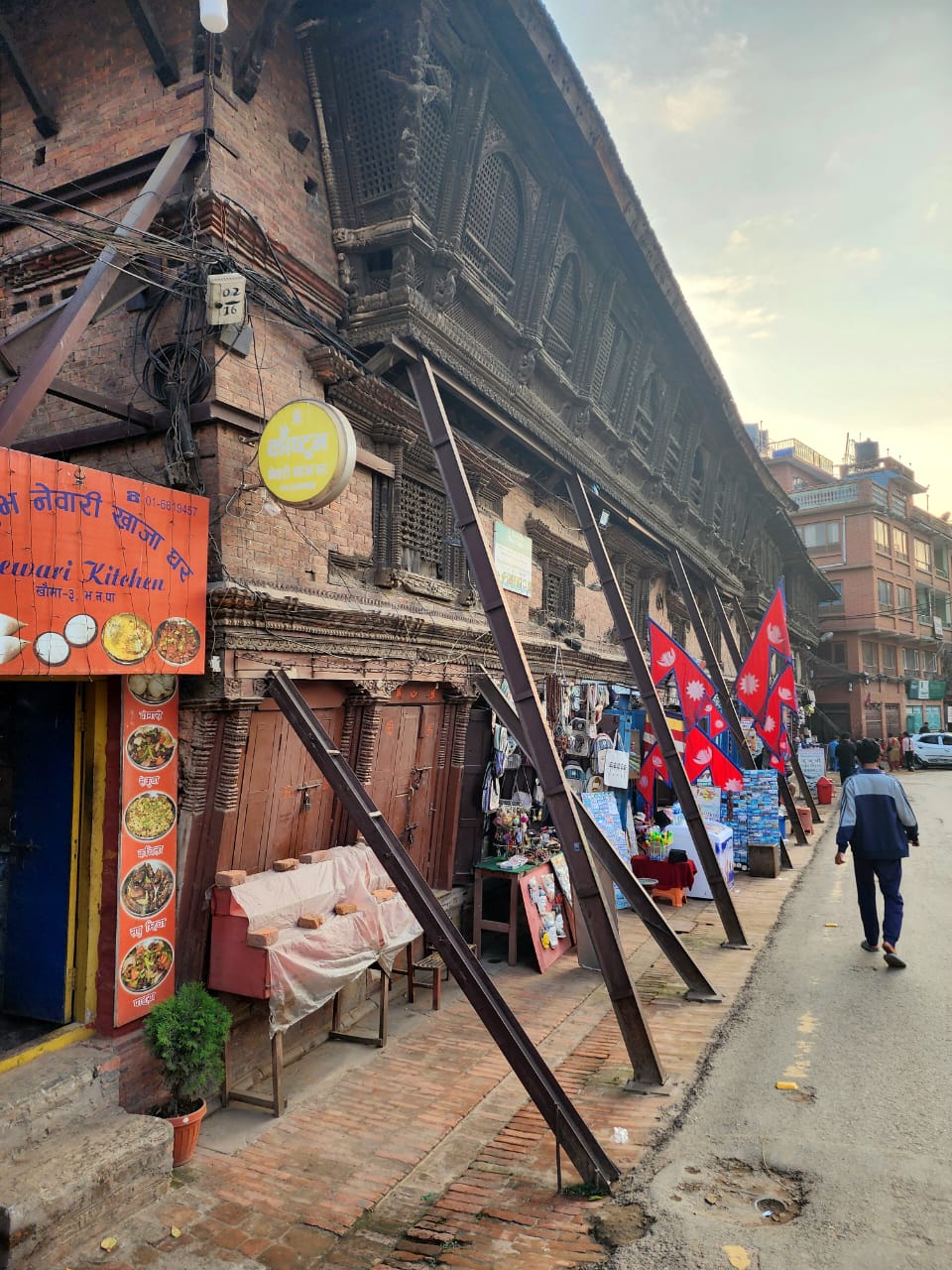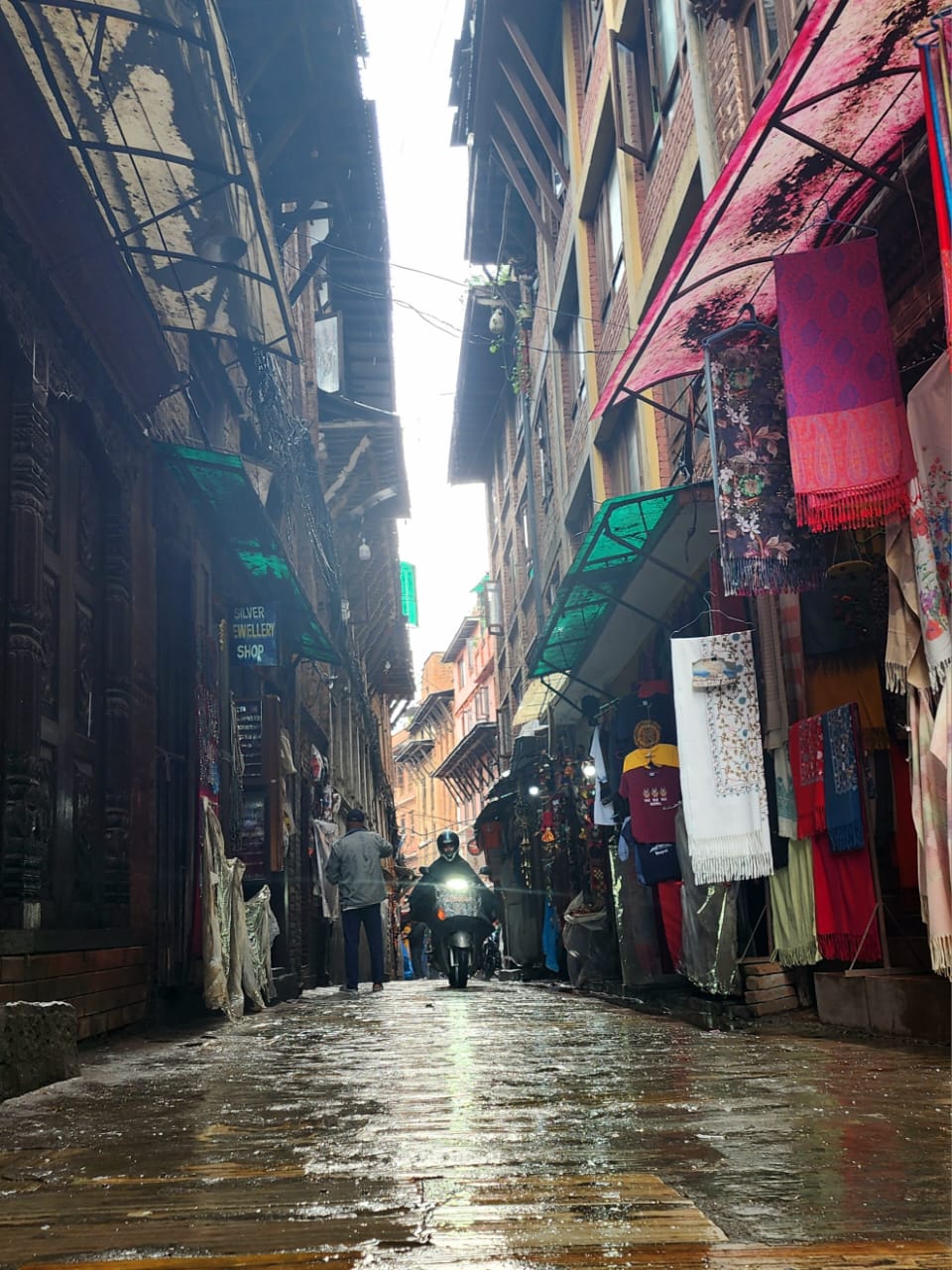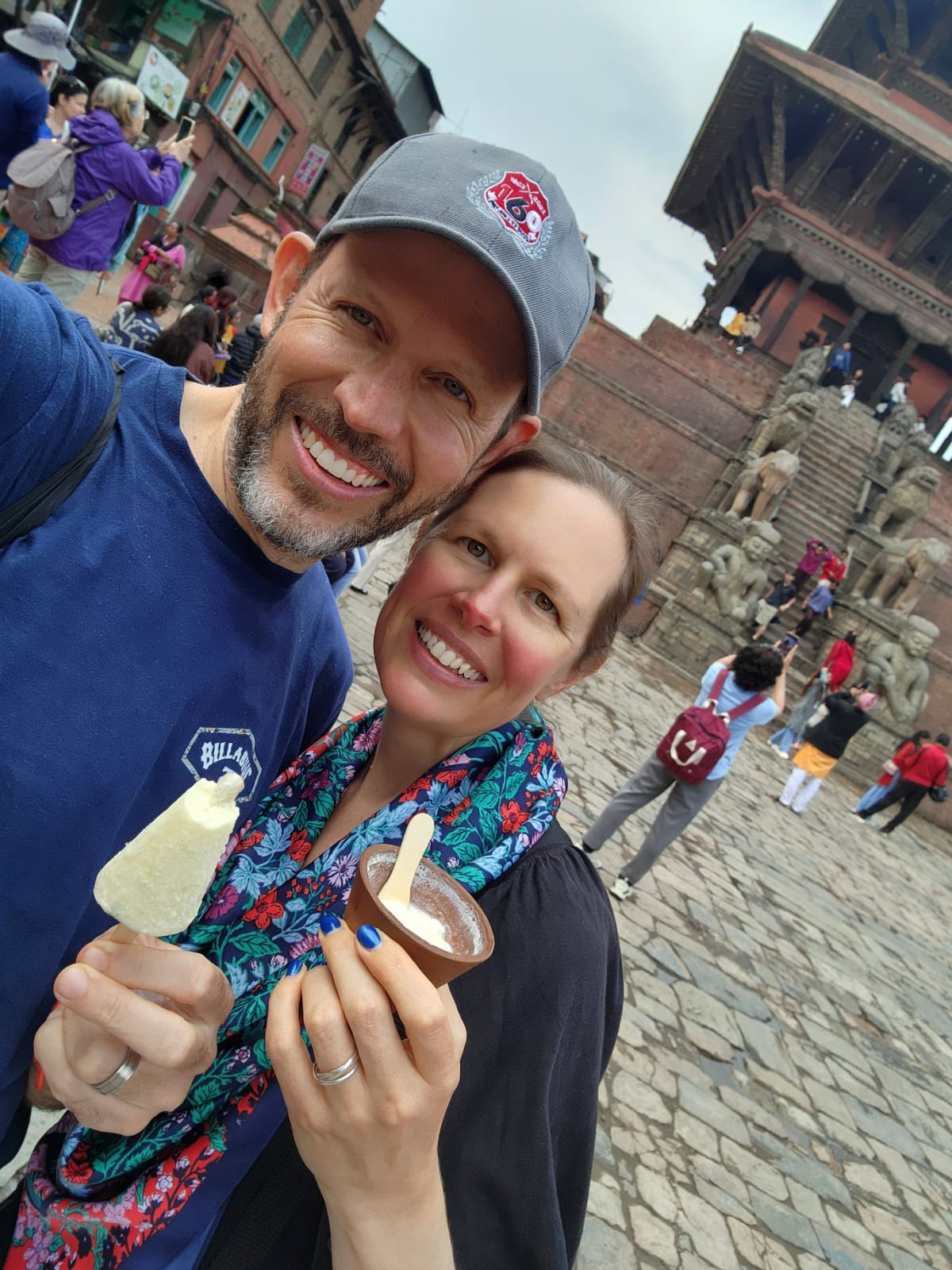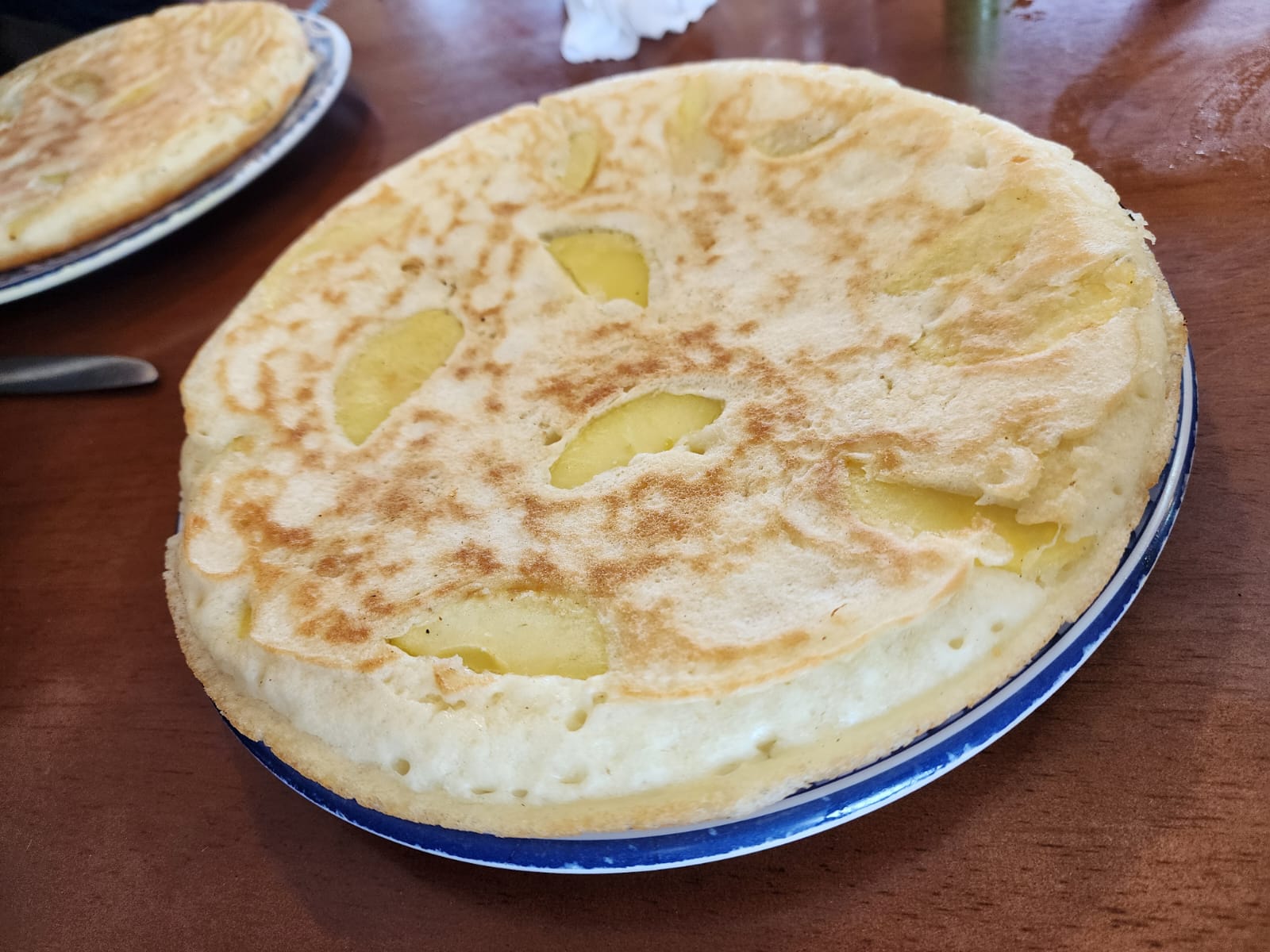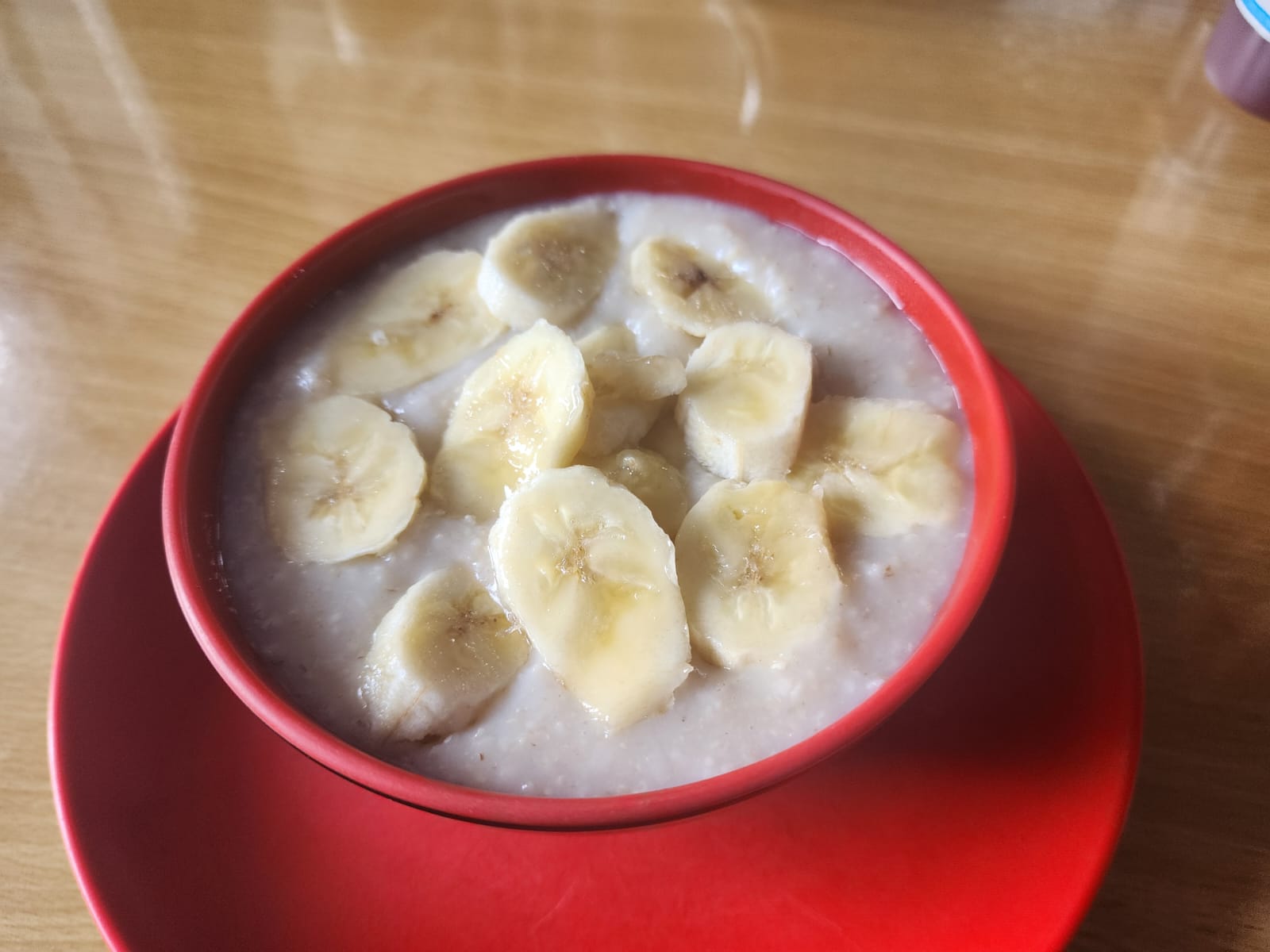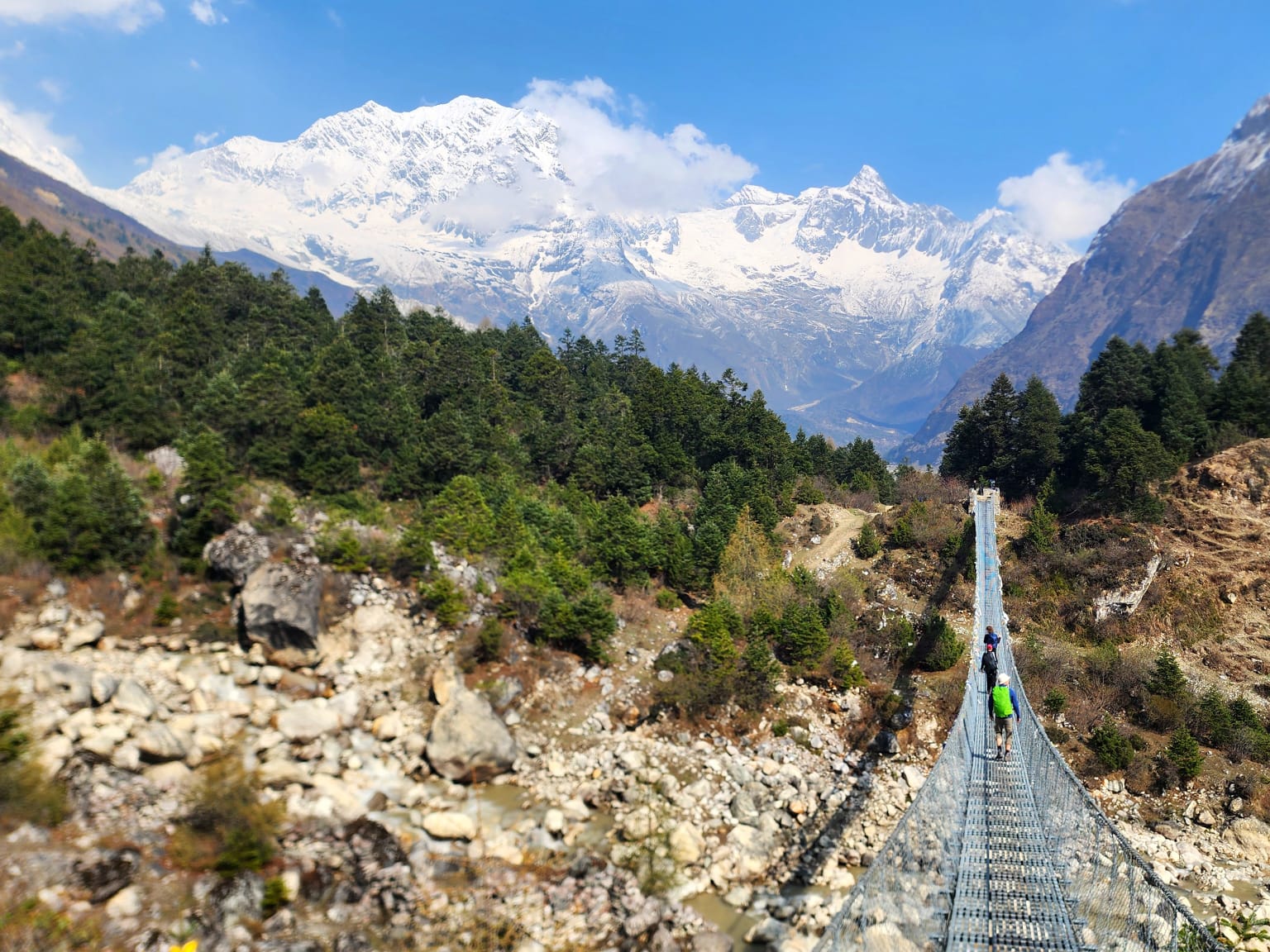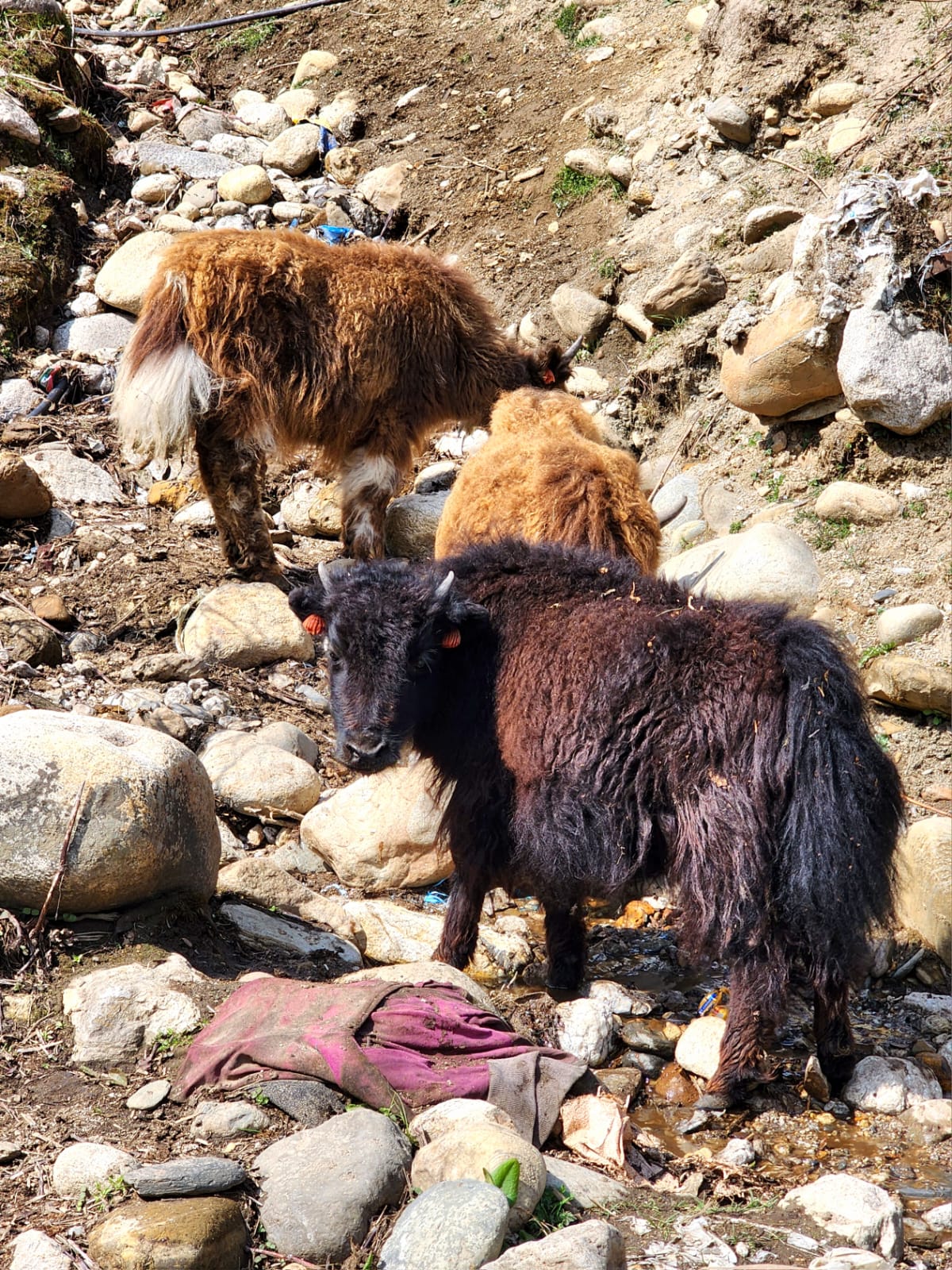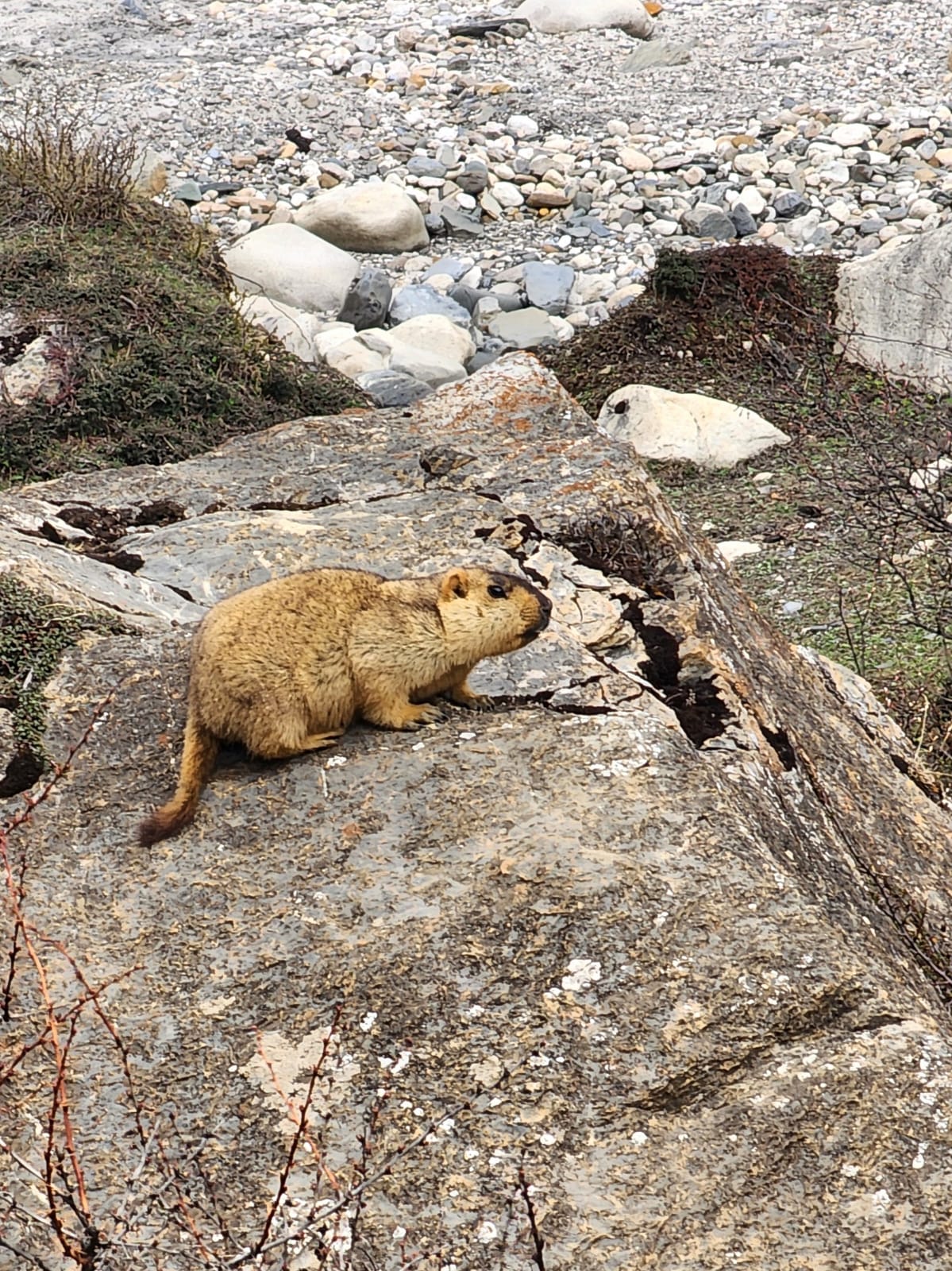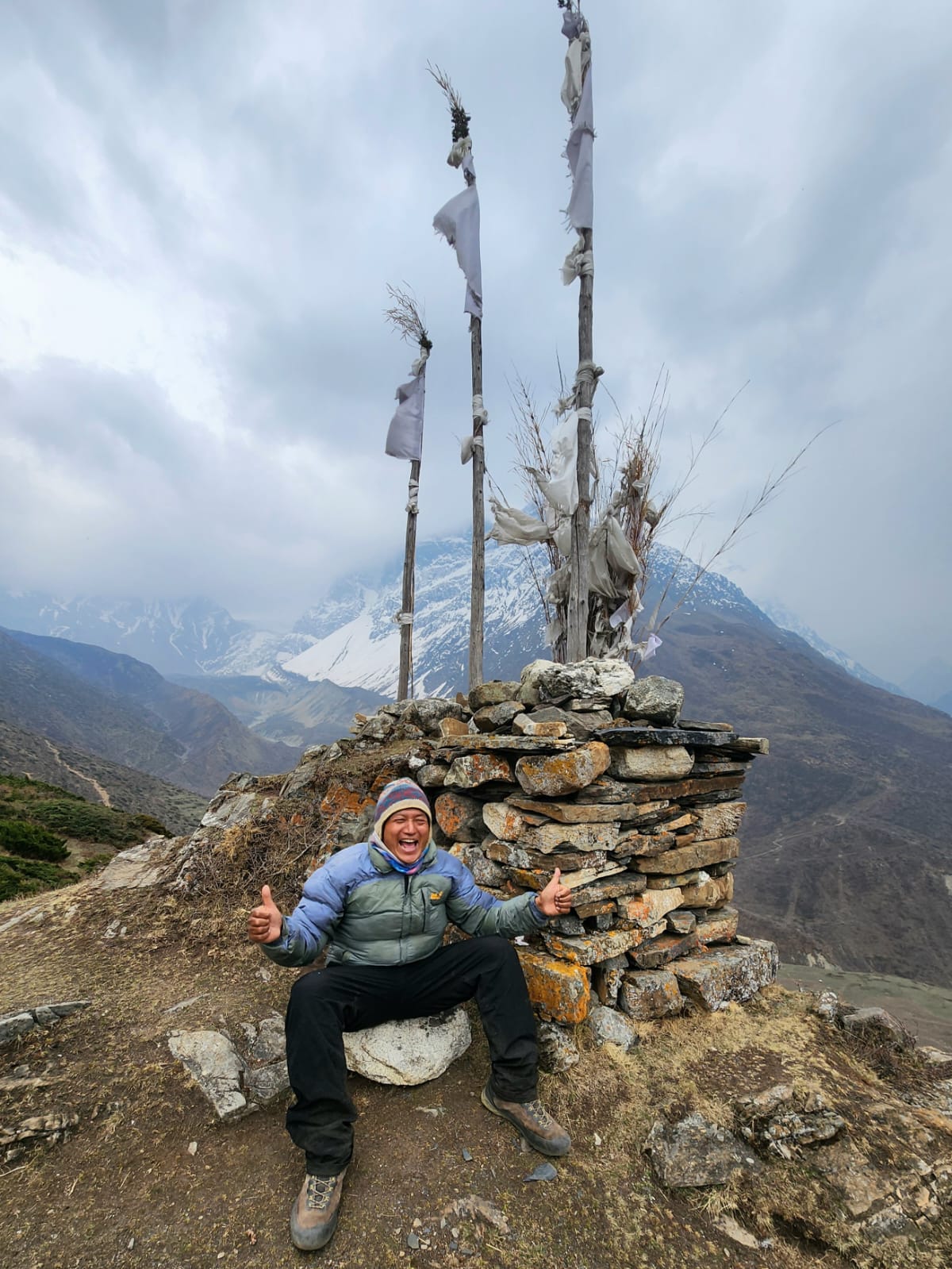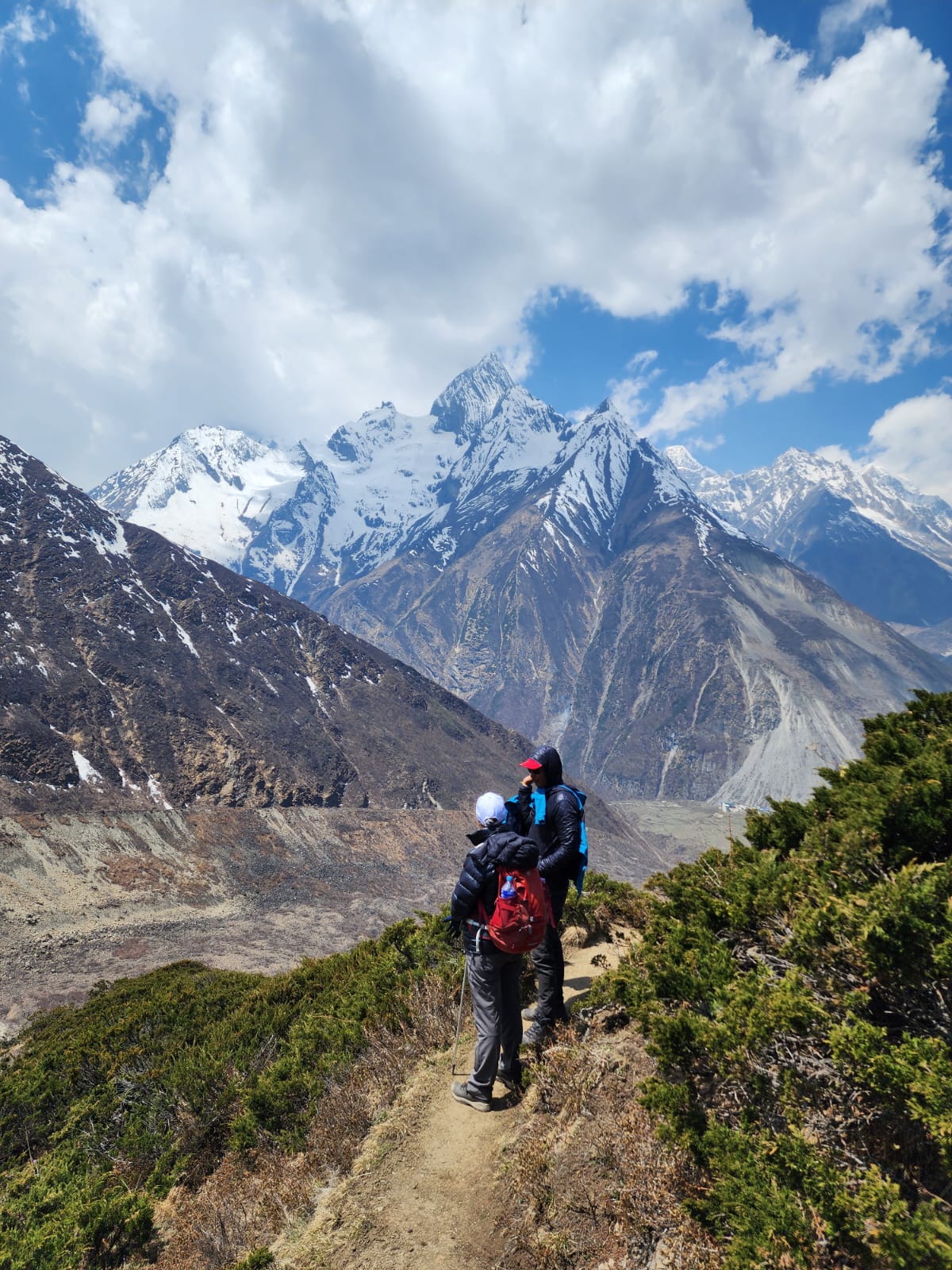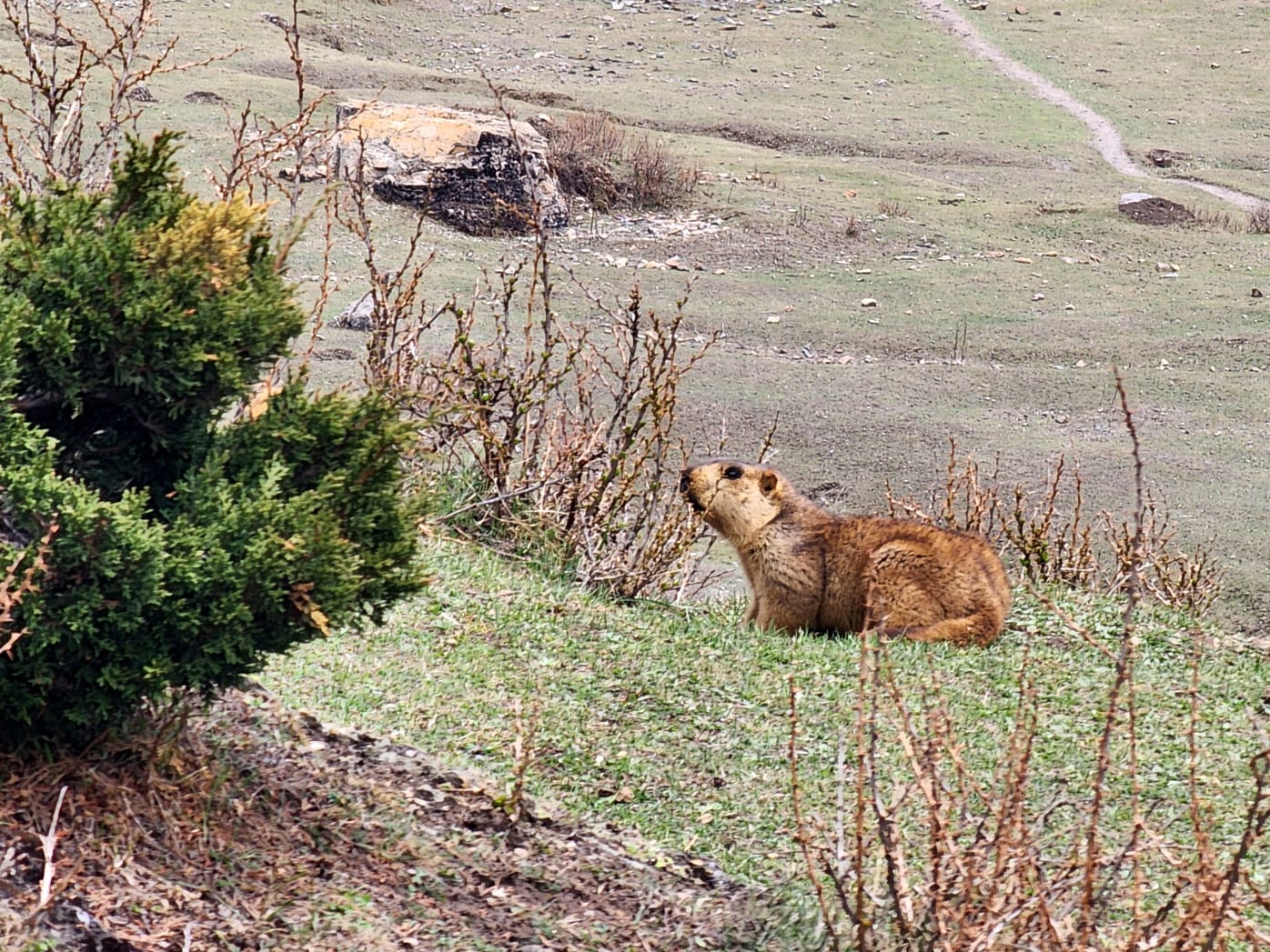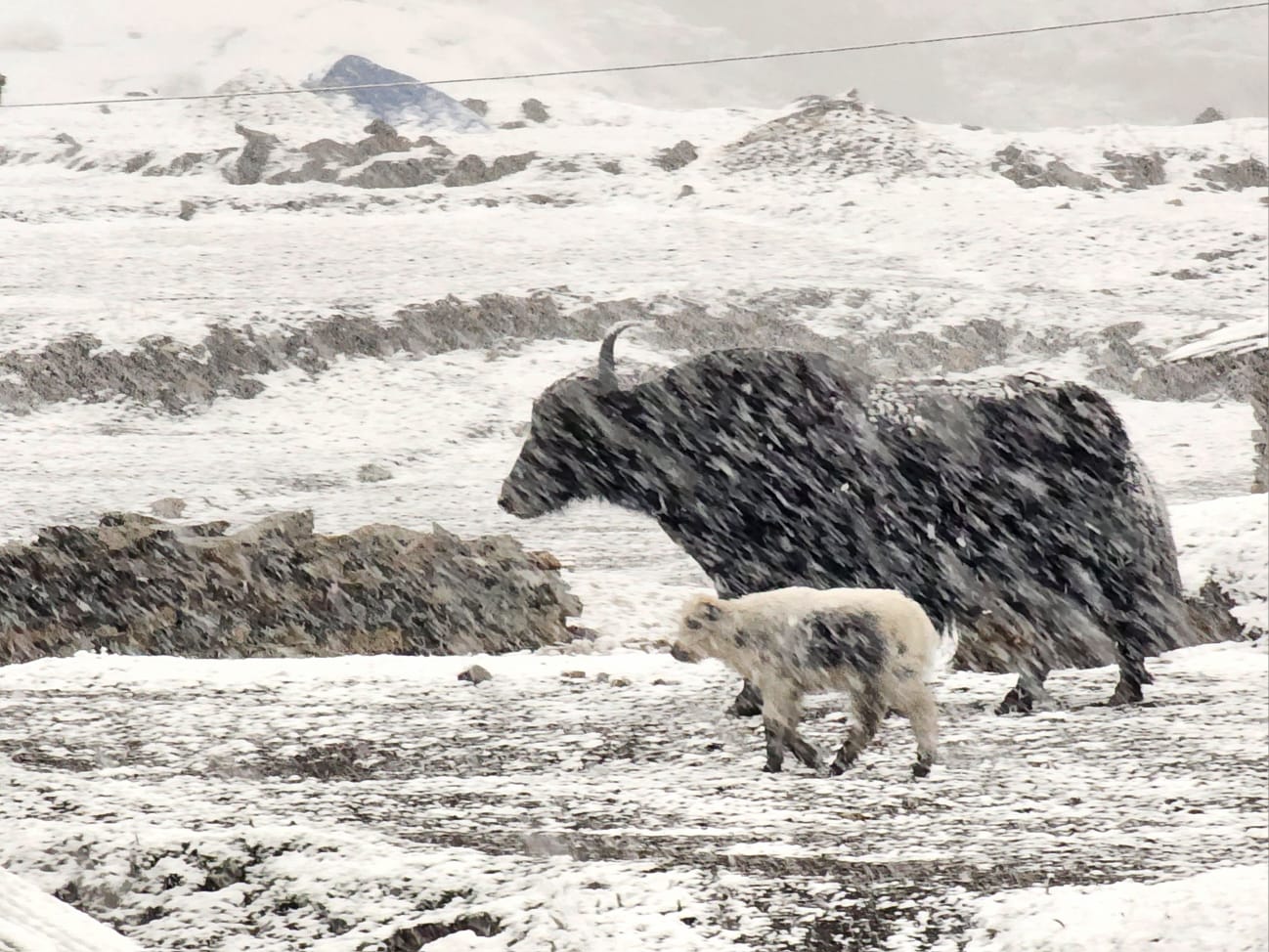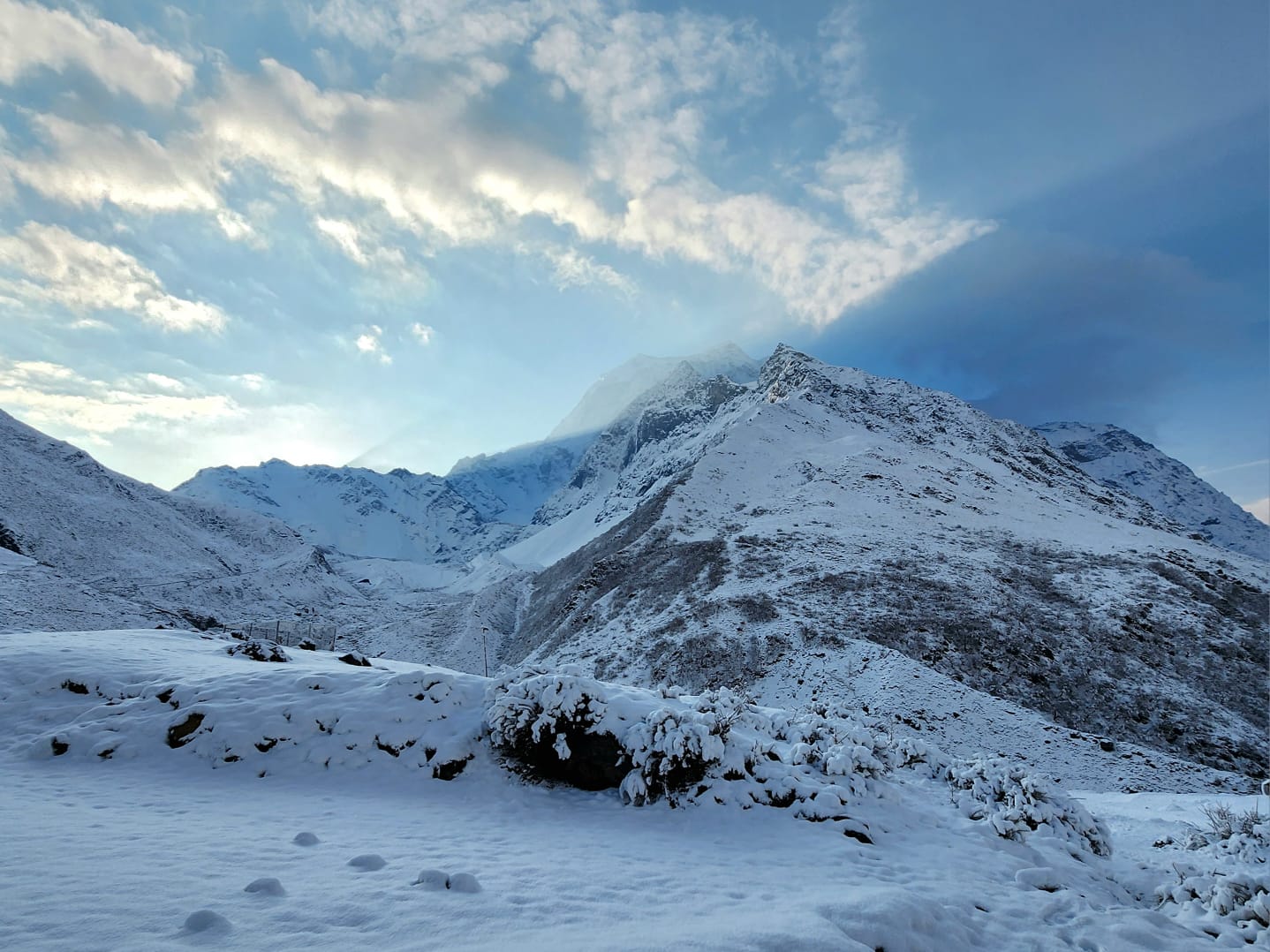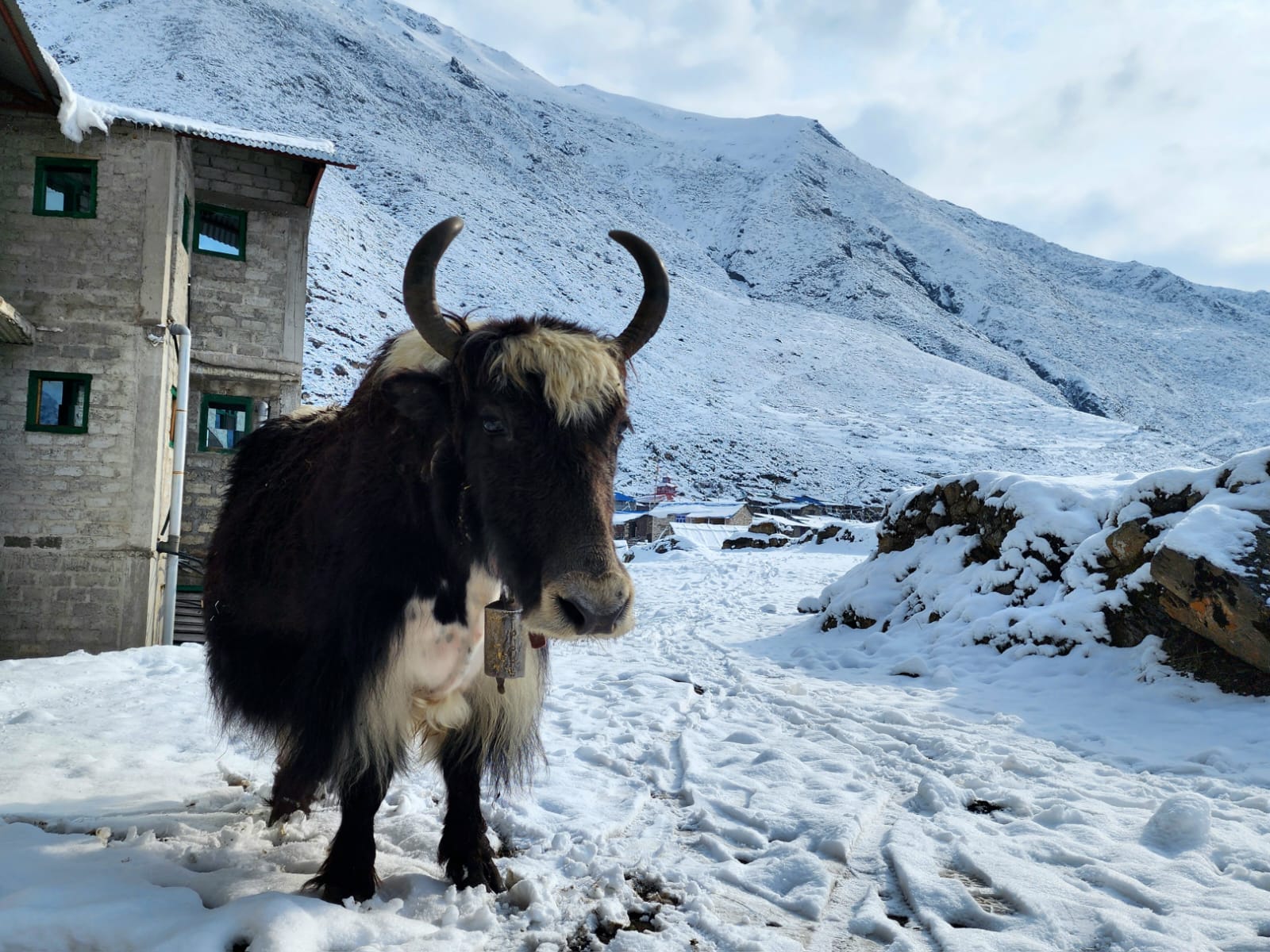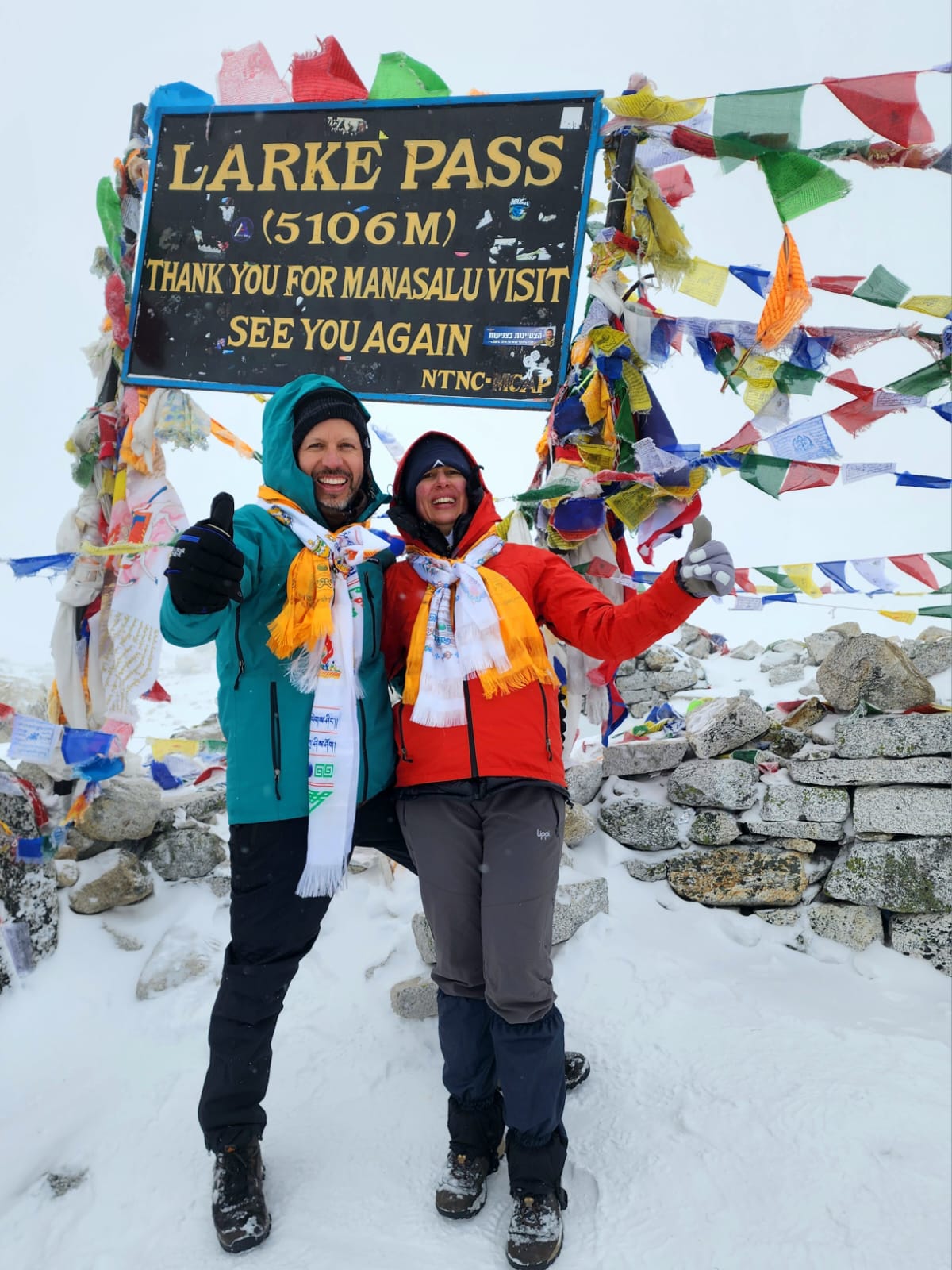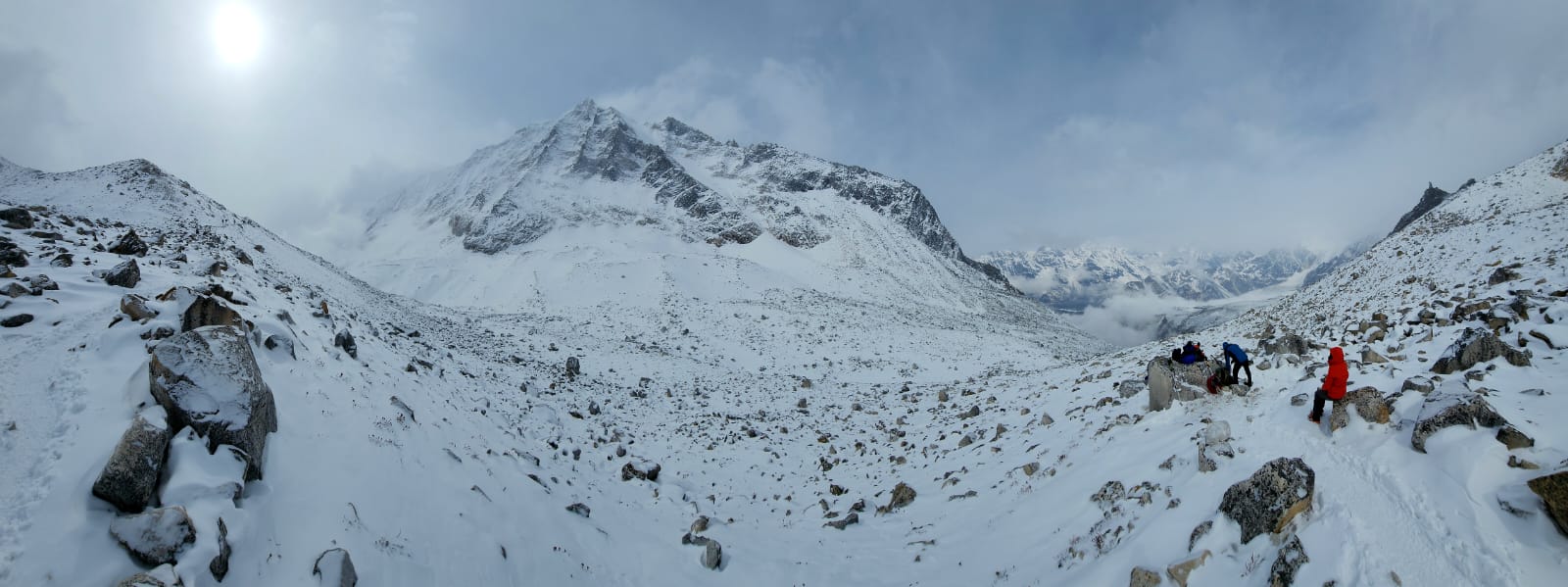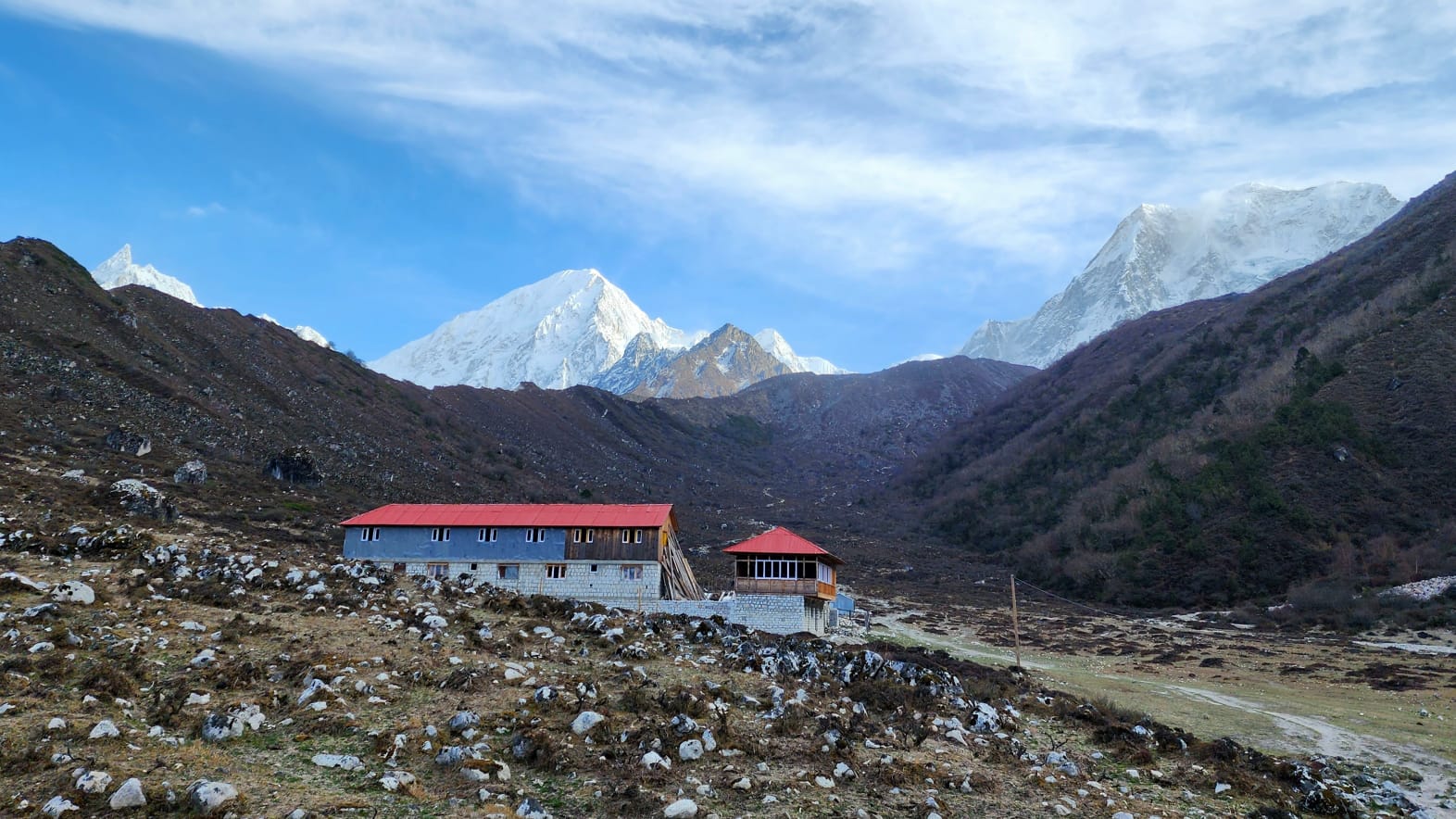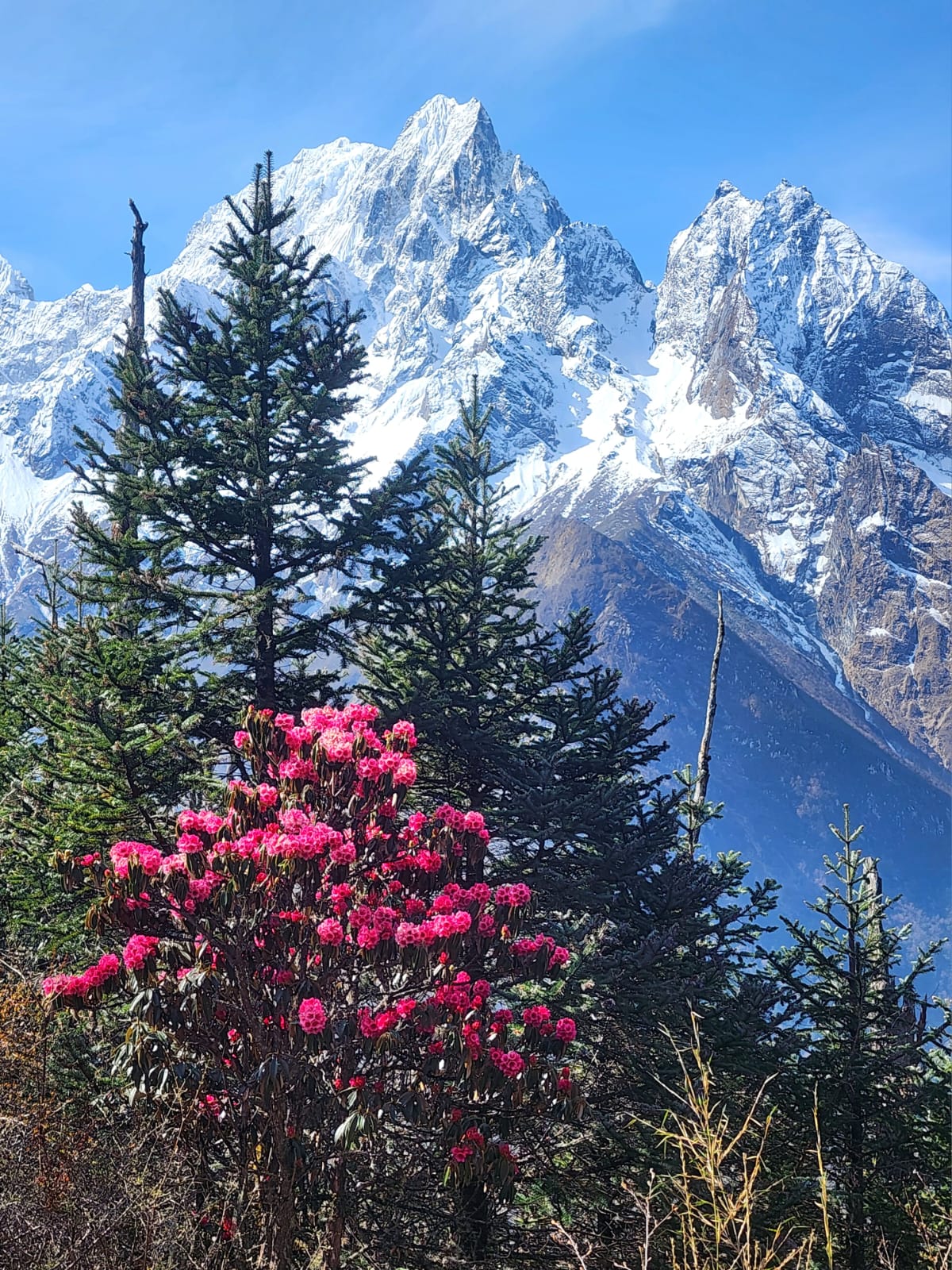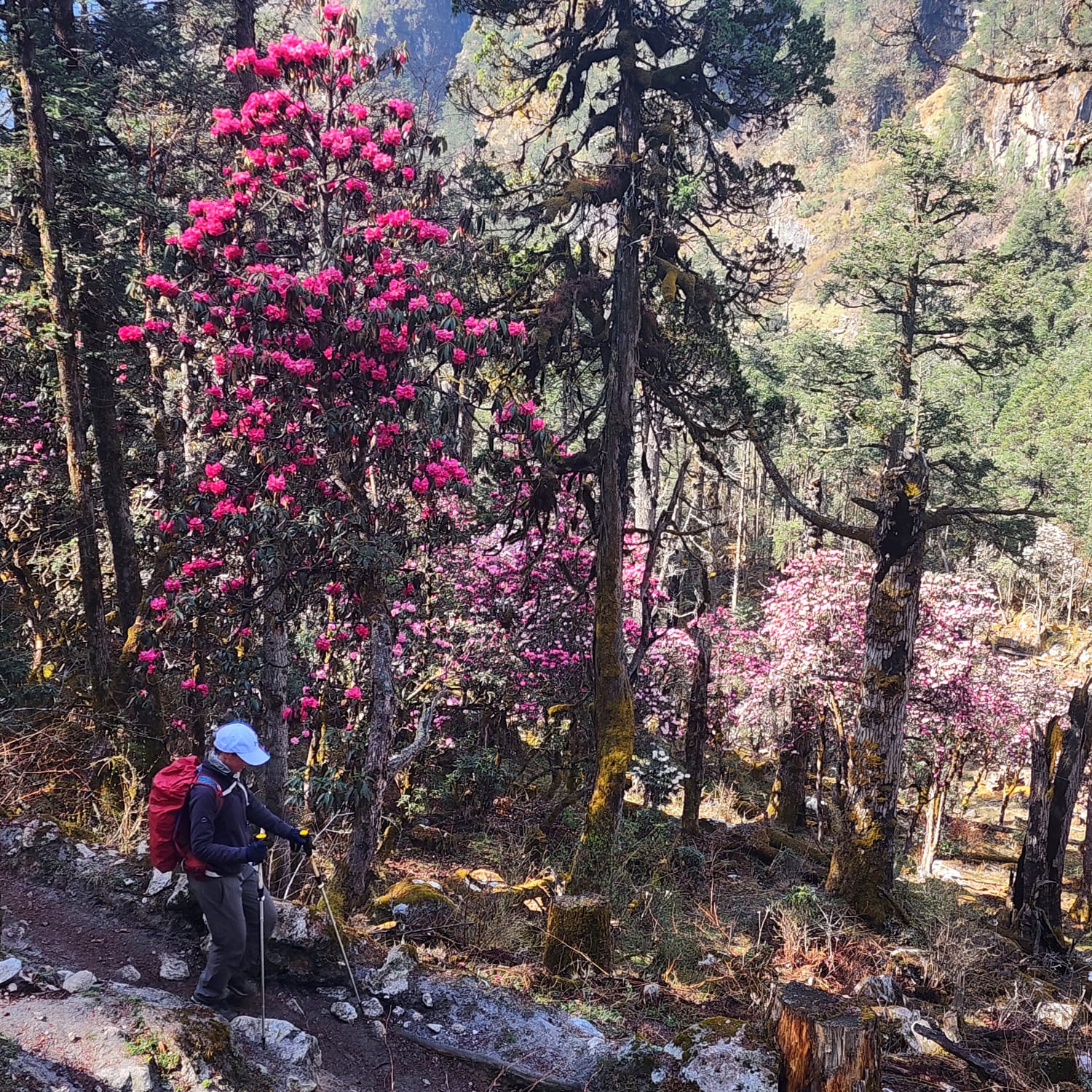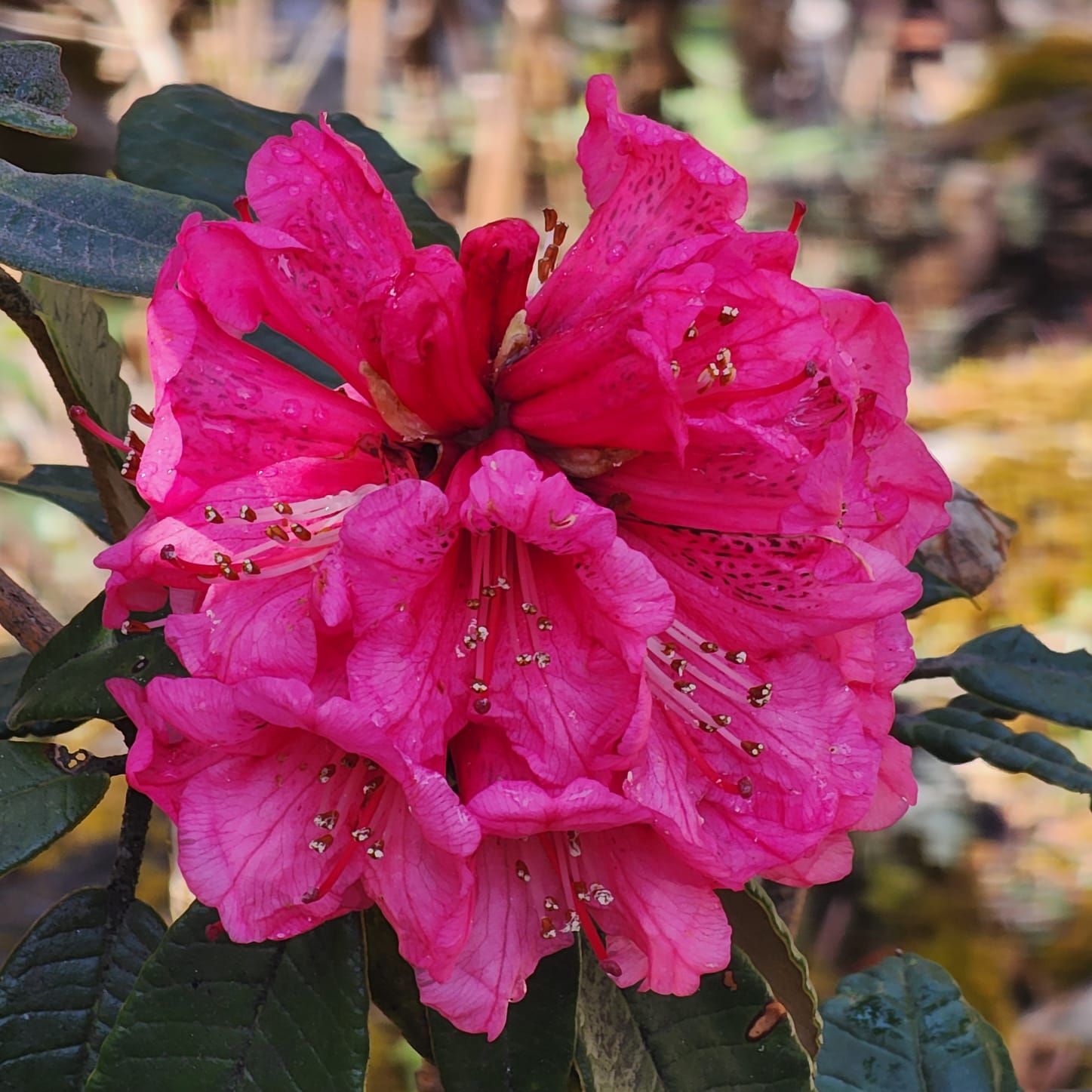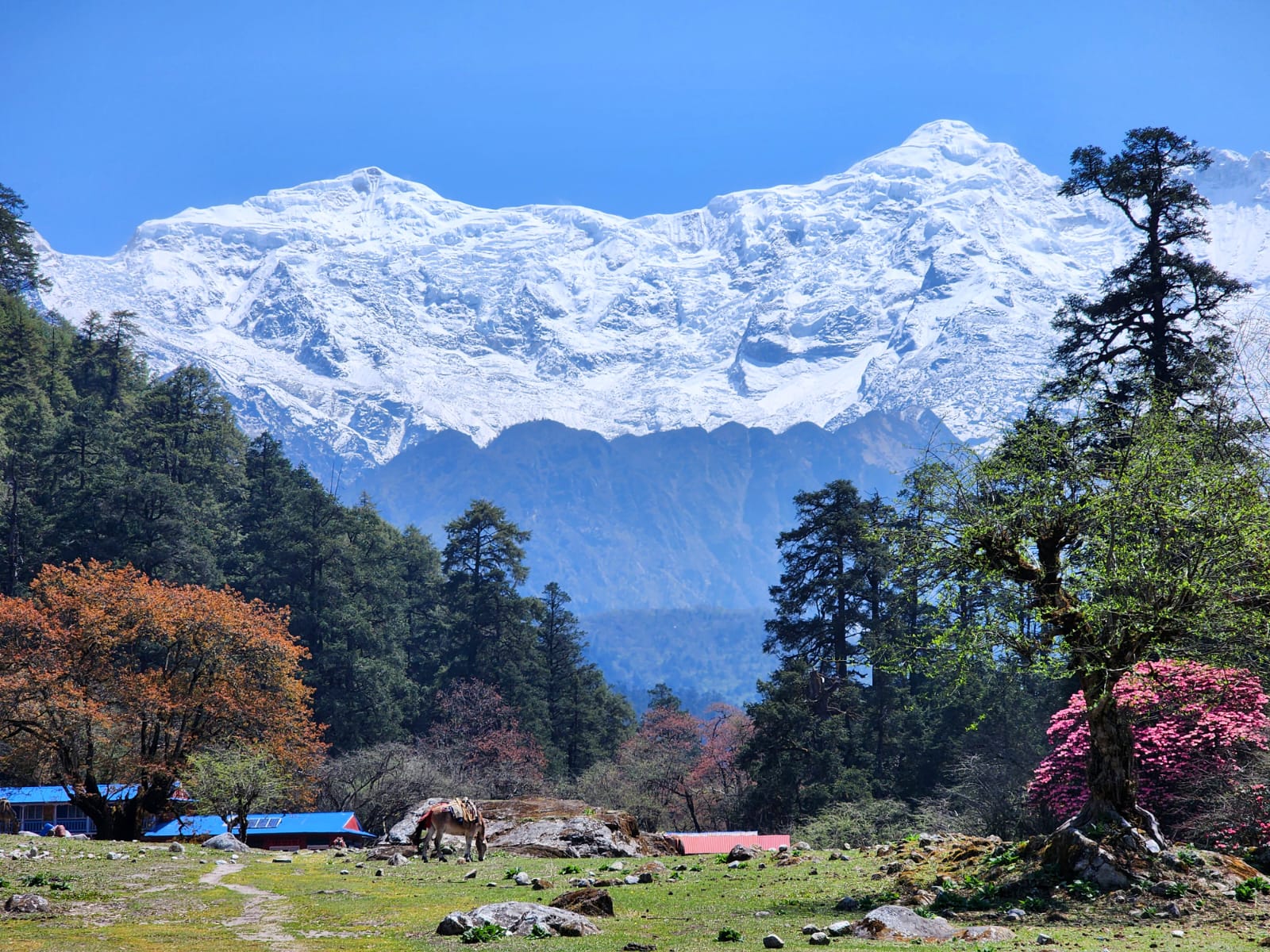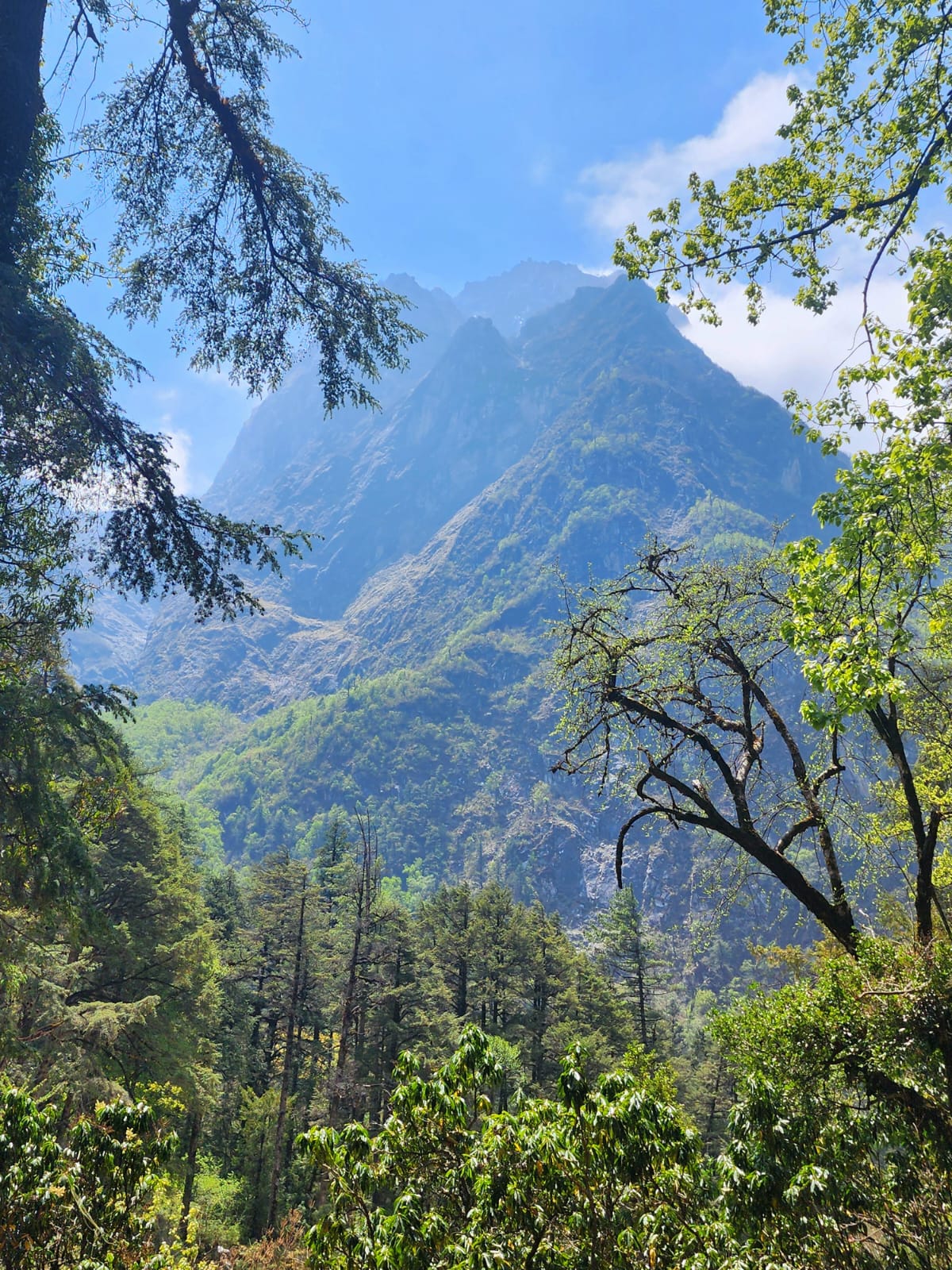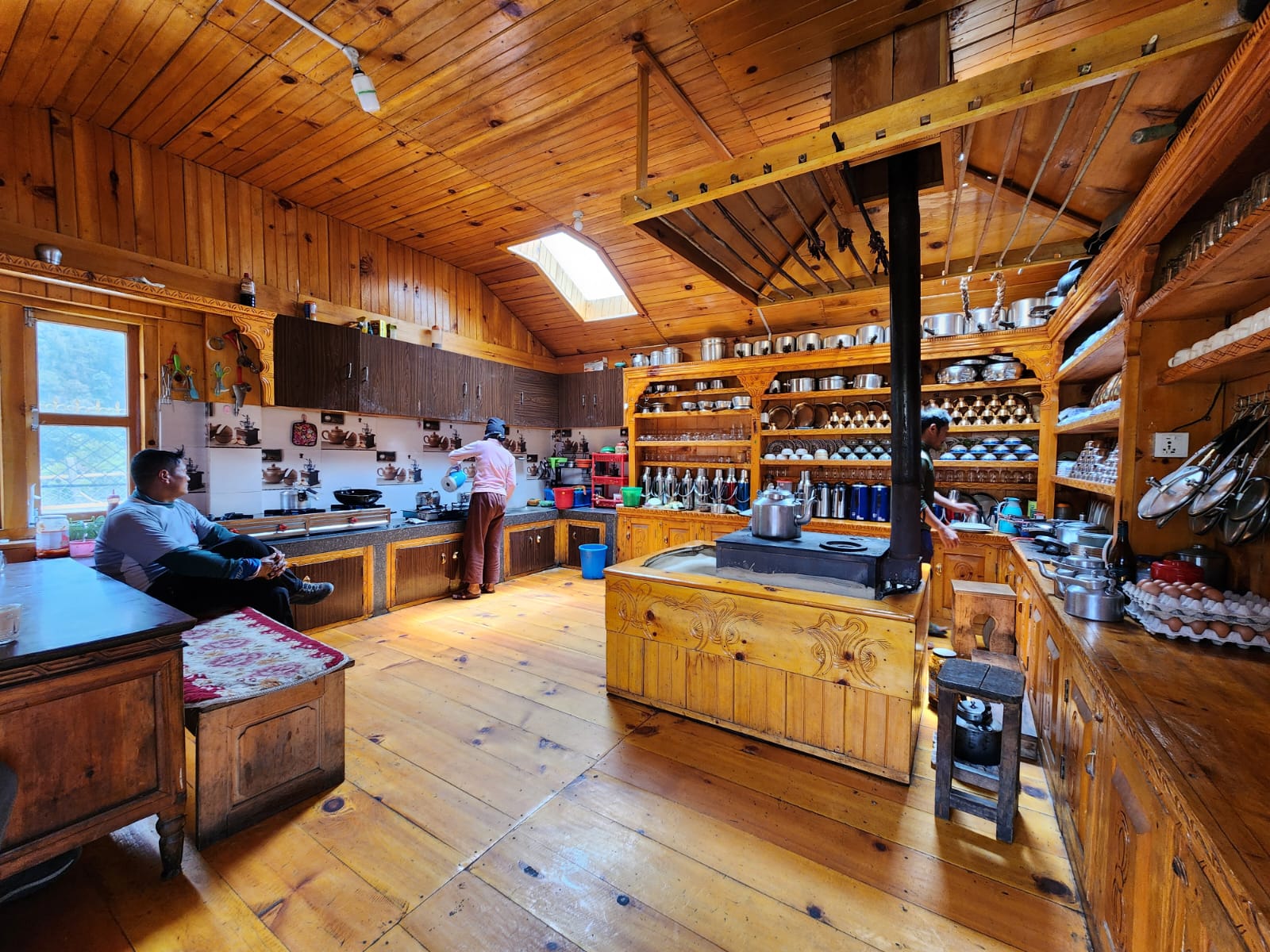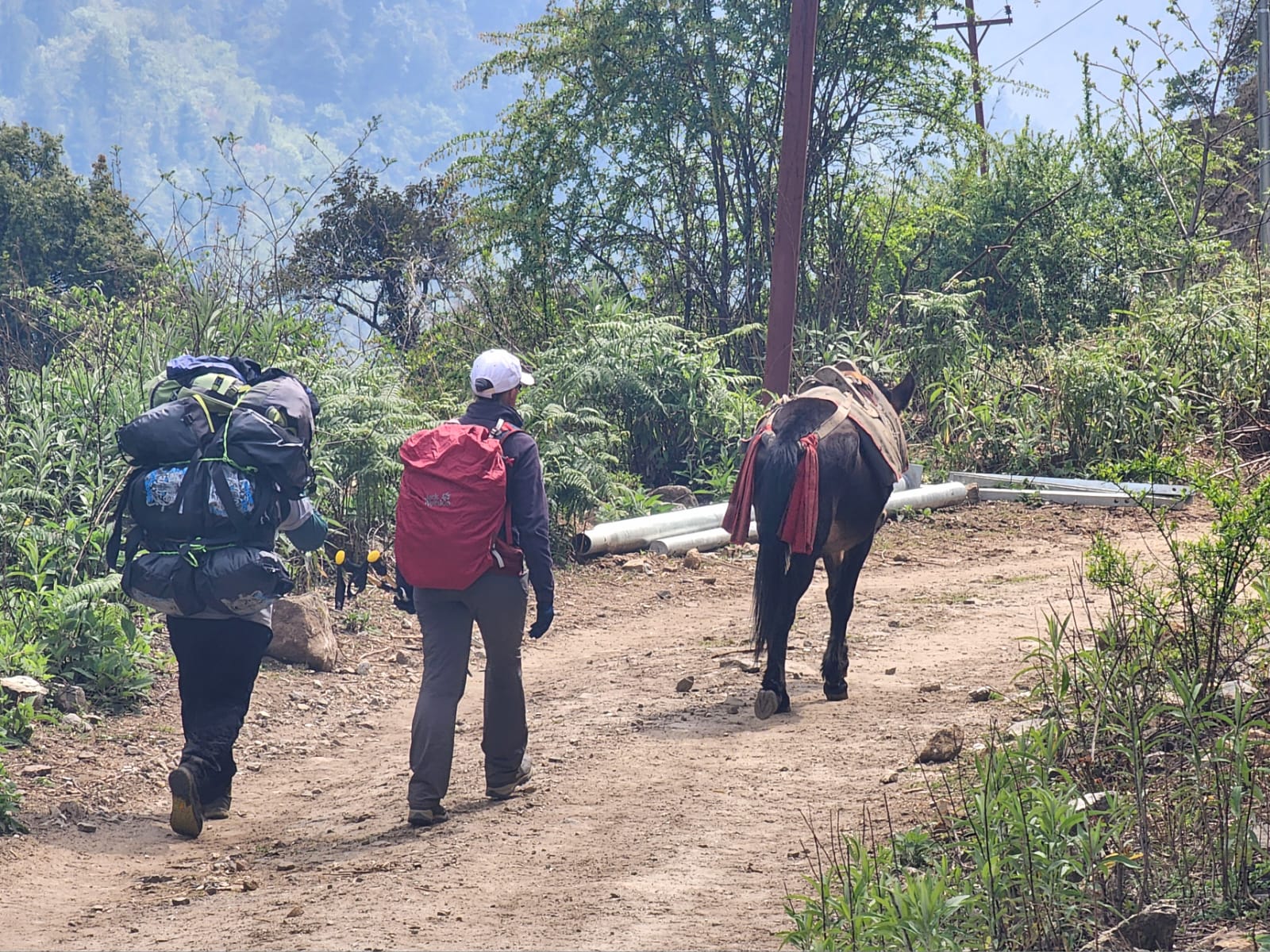Day 5 of the trek saw us leave Namrung and head to Lho. The original itinerary had us staying in Lho for the night and moving on to Samdo on Day 6, but Bashu had discussed with us about the possibility of continuing on from Lho in the afternoon to reach Shyla and overnight there instead. We all agreed we would see what time we arrived in Lho and if it was raining or not and make a decision from there. We arrived in Lho at midday to good weather and decided to continue on from Lho to Shyla.
Leaving Namarung or in Lho, can't remember exactly...
The afternoon walk was a steady 300m climb over ~2 hours through beautiful ancient forests with a clear stream running right next to the path. The walk itself was fairly tough going but it was also so beautiful, relaxing and restorative. We were also glad to end the day with this climb rather than starting the next day with it. It would have been a very long day to walk from Lho to Samdo, we were all happy with the decision to continue on and overnight in Shyla. At this altitude we were breathing a bit harder on the climbs, flat and downhill were fine, but we definitely noticed an increase in effort on the inclines due to the decreasing oxygen. We had been taking diamox for a few days in preparation and think it helped us. And our bodies did acclimatise over time, I felt I was breathing less hard on the last climb to the pass on the last day.
We reached Shyla at 15:20 with lots of time to relax before dinner. We took a short walk to a nearby Buddhist Monastery overlooking the town where we were followed by a local drunk. It was a strange encounter and detracted from an otherwise lovely place.
Ancient forests with the most wonderful clear water stream flowing through.
A steady climb up all afternoon in beautiful surroundings.
The monastery in Shyla
View from our teahouse.
Bron was so excited for the outdoor space but it was way too cold to sit outside lol.
Our spacious but freezing cold room in Shyla
The view from the teahouse in the morning
At Shyla there was a noticeable drop in temperature. Bron was very happy and excited to see a lovely large table outside our teahouse and was ready to sit there all evening, until we realised how cold it was lol. Out came the beanies, fleeces and gloves, and there was no sitting outside until we were back in the city. We had a large room by teahouse standards but none of the wooden panels matched up and the wind came straight through. It was extremely cold and we were concerned about the next few days going higher up. Fortunately this was the coldest and breeziest teahouse we stayed at. Each teahouse also provided a blanket (was more like a duvet) and pillow for each bed, here in Shyla was the first time we used the blanket.
Dinner in Shyla.
Fried rice with an omelette and soup for Justin, veg noodle soup for Bron.
Thanks Mom for my beanie! Happy to finally get a chance to wear it.
And I knitted Justin's beanie =)
Let’s talk about food for a moment. We ate really well all trek and also lots lol. We still each lost at least a kilogram though, from the physical exertion and just burning energy to keep warm. We both decided to stick to vegetarian options due to uncertainty about the meat the higher up you go (Bron is a veggie anyway). And we avoided dairy (to keep chests clear), alcohol (not recommended at altitude), and fried food. There also wasn’t really snacking inbetween meals, except for a few biscuits at morning tea time. We ate very clean but also big portions lol.
Lower down up until about Day 5 we ate a lot of dhal baat for lunch and dinner. Some of them were extra yummy with added beans and things. The potato curry on the side also varied, sometimes with pumpkin or chickpeas. Sometimes there was cabbage instead of saag. When we had unhappy tummies we ate potatoes, either boiled whole baby potatoes or a soup (just peeled potato in hot water lol). Justin sometimes had fried rice with mixed veg but not often. Higher up we switched from dhal baat to veg noodle soups for lunch and dinner and Justin sometimes had veg momo (too spicy for Bron lol). In the beginning we had chapati and omelette for breakfast, later on Tibetan bread and omelette, and also usually with honey or mixed fruit jam. Higher up we had plain or apple pancakes for breakfast and after the pass we enjoyed oats for two mornings (we would have had oats more often but it was prepared with milk which we were trying to avoid but after the pass it was ok). Bron loved the milk tea in Nepal, on trek though we stuck to ginger honey tea and higher up even just hot water. In Dharapani that first milk tea was a real treat! For daily drinking water, we filled up at the common area and added water purification tablets, after 30 minutes the water was safe to drink. We never had any problems with the water. Locals just drink the water straight but it is advisable for foreigners to use the purification tablets. We brought refillable bottles with us to use and occasionally bought a plastic bottle when needed. We drank around 4 litres of water a day so reusing bottles is a must.

Dhal baat for lunch in Lho
Tibetan bread with an omelet for breakfast in Shyla
Fried rice with omelet, not sure where, maybe Deng?
These were probably in Samdo.
Apple pancakes in Samdo
Oat porridge with banana in Dharapani
This 10 day hike circumnavigates Manaslu, the eighth tallest peak in the world. Around Namrung and Shyla was where Manaslu could be seen but unfortunately we didn’t really get to see it, it was too cloudy in both Namrung and Shyla. Generally the mornings were clear and the afternoons cloudy with some rain on most days. We were hoping it would be clear in the morning in Shyla but there was still some cloud shielding the peaks. That was a shame but we still had plenty of amazing mountain views.
This is all we saw of Manaslu peak leaving Shyla.
But still, spectacular views all around.
Day 6 then saw us walk from Shyla to Samdo via Sama Guan. Most people stopped in Sama Guan and had a rest day here with an acclimatisation hike, but we carried on to Samdo and were glad, the accommodation in Samdo was really nice and with the way the weather panned out we were glad we were in Samdo when the snow came in.
Sama Guan is only about 2 hours walk from Shyla. It is probably the largest village we passed through the whole trek, and the only village the whole of that day. Usually we have a tea break in the morning and lunch later, but since this was the only village, our guide and porter wanted to have lunch here. It was too early for us and too soon after breakfast so we took away a packed lunch of Tibetan bread and omelette to eat later. Sadly we waited around 90 min for this lunch and wasted the good walking weather of the day. It would have been better to just have tea in Sama Guan and move on and have lunch in Samdo, but anyway. We used the time to have a walk around the village and managed to stock up on biscuits and wet wipes. And found some sweet baby yaks to watch, they were very chilled and didn’t mind us too much.
Villages and farming on the way from Shyla to Sama Guan
On the way from Shyla to Sama Guan
We loved all the yaks so much!
View over Sama Guan
The walk from Sama Guan to Samdo was the most open of the whole hike, through open grass plains where we saw people ploughing and planting the traditional way with oxen and sowing seed by hand. Here we also saw lots of active fluffy chubby little marmots. They were curious but cautious and ran away and hid easily. And lots of yaks! We loved the yaks so much. They are owned by farmers in the area but allowed to roam free and we saw them all over. They are of the bovine family with much thicker and shaggier coats than cows and can only live in high altitudes.
We stopped at the end of this Buddhist prayer area for our takeaway picnic lunch of Tibetan bread and omelet.
Chonky little marmot!
Traditional ploughing and planting
Last stretch to Samdo
The morning was already cloudy and the weather continued to come in through the day. By the time we reached Samdo, it was cold, windy, and starting to sleet. Bashu always pre-booked teahouses for us but these bookings were not always honoured. When we reached Samdo, the teahouse was very full and they tried to turn us away. Fortunately Bashu managed to get a room for both us and them. We were lucky as this was the best place to stay in Samdo and we would be here for 2 nights so was definitely worth trying to get in. We also discovered later that there was a sitting toilet!! Much happiness for two days lol. The toilet also had the best view over some of the nearby hills and we enjoyed watching the yaks in the field behind the teahouse during bathroom breaks.
The principle at altitude is hike higher and sleep lower. So on arrival in Samdo we did a short but very steep hike up 100 m to a viewpoint, stayed for about 15 minutes and came back down. It was very cold, sleeting, and windy by this point. But we managed the hike and were glad we did it. Bashu and Nara also came with us for every acclimatisation hike. On the way down we saw the cutest baby yak, he was so small, the smallest we’d seen, and estimated to be a month old. He was so happy and cheerful, jumping around and wagging his little tail. We would see him a few times over the next few days and a last farewell as we walked out of Samdo on Day 8. He was such a joy to watch, little guy.
It snowed a bit in the afternoon and evening but didn’t settle and was all gone in the morning. Bashu told us a friend of his had done the Larkya La Pass a few days before and it was dry with no snow. So that is what we were expecting. Little did we know what the weather had in store for us!
Acclimitisation hike Samdo.
Bashu and Nara are both lovely friendly guys with beautiful guys, but getting Nara to smile in photos in mission impossible! We were so happy to get this natural gleeful snap of him!
If Milo was a yak this is what he would look like 💗
We thought this was his Mommy, but it wasn't, we would see him with his Mommy in the snow the next day.
The next day, Day 7, we woke to a beautiful clear and calm morning. A very welcome much slower start and later breakfast today. Today was a rest day with a short 3 hour acclimatisation hike. We walked to the top of a local hill for some great views of the surrounding mountains and a glacier. The Tibetan border is not far from Samdo, about 9 km each way, but it’s at ~5100 m with a gain of ~1200 m, equivalent to the Larkya Pass on Day 9. We really wanted to do this hike also but decided to preserve our strength and energy for crossing the Larkya La. If you want to incorporate this day hike into your Manaslu Trek, add an extra rest day in Samdo.
We took it nice and slow with frequent rest and photo breaks. It was so beautiful and peaceful with amazing views, close encounters with yaks, vultures circling overhead, and the occasional marmot sighting. At first glance, the scenery looks brown and desolate with no life, but if you look closer everything is alive and growing. There are no trees here, but there are some scrubby bushes. They are all just stalks however, and I wondered at what time of year they get leaves, but apparently they never get leaves. But if you look closer, they are growing! The new growth is red and the rest of the shrub is brown. And there were lots of little grass flowers and things. There were lots of little birds and smaller animals. I had the best bush wee here lol, perfect views and up close with the vegetation and smaller things.
The walk up is always very steep, but Nara navigates us down a much gentler path down fortunately. On the way down, we came across the sweetest little baby yak again just enjoying life and being a happy little guy. We enjoyed watching his antics. After lunch we had free time. Bron had her sights on a nap but it was recommended not to nap as it would affect our night time sleep which is already difficult at altitude. So we decided to camp out in the dining hall for the afternoon and secure a spot. This teahouse was so full and busy, the dining hall was always crowded. There were some big groups of 8 to 15 people prebooking tables, as only a group of two people it was difficult to get a spot. We were early and managed to get a table, and were joined by another group of three and had a lovely afternoon of chatting, drinking tea and playing cards. The one guy in this group did the hike to the Tibetan border and was very ill the next day. Not good timing with the Larkya Pass crossing the day after (he was much better by the time of the pass but was still sad to see him so unwell).


Acclimitisation hike on our rest day in Samdo
View of Samdo
Part of our trip preparations included getting travel insurance that also included helicopter evacuation. We had quite a time finding a reasonably priced insurance provider. In Samdo we realised why. Everyday there was a helicopter evacuation due to altitude sickness. Apparently it’s even more frequent on the Everest Base Camp trek, with a helicopter seen almost every thirty minutes. And indeed back in the city we noticed the helicopters going about all day long. At Everest it’s easy to arrange a helicopter and one can arrive within 45 minutes. However, in the restricted areas such as Manaslu, it can take up to 6 hours as additional approval is needed. Please don’t have an emergency in a restricted area! There is a large open field behind the teahouse that the helicopters land on. We saw huge boxes of fresh eggs being carried out of the helicopter so guess that’s a convenient way to deliver supplies. If the helicopter is coming anyway and there is time to arrange it, why not.
While we were enjoying a relaxing afternoon in the dining hall, it started snowing at around 15:00. We thought it would burn off and not settle but it snowed harder and by the time we went to bed (at 20:00 lol) the ground already had a good layer of snow. We felt sad for the yaks in the field but they didn’t seem bothered at all. We didn’t realise that at higher altitudes it doesn’t rain, it only snows. So when you see dark grey clouds in the high peaks you know it’s snowing. The next morning, we woke to a real winter wonderland with everything covered in white. It was so beautiful and completely transformed the area. Our thoughts and expectations of a dry crossing suddenly changed!
Baby yak in the falling snow with his Mommy
When it started snowing in the afternoon of our rest day in Samdo
What we woke up to the next morning, a real winter wonderland
It doesn't look like much but was very cosy and at least the wind didn't come whistling through the walls!
Typical evening conversation:
Darling, please put the central heating on before we go out to dinner.
Sure dear, already done.
Apart from the occasional headache earlier on, we had been feeling well and didn’t feel much affected by the altitude so far. We had been taking diamox and generally felt well. On Day 8 Bron woke up feeling nauseous and wasn’t able to finish her pancake at breakfast, unusual as we usually had great appetites. Previously in Peru Bron had had cramps and an unhappy tummy due to altitude, but I don’t remember any nausea. This was not good timing with a 4 to 5 hour and 500 m climb that day and the crux of the trek, the Larkya La pass, and 10 hours of hiking the next day.
Usually we didn’t walk with many people but on our own just the four of us. However, at this point of the trek, everyone was going in the same direction and everyone leaving Samdo today would be staying in Dharamsala tonight and crossing the pass tomorrow. Everyone was keen to arrive in Dharamsala as early as possible as there was a rumour that there isn’t enough space and the last to arrive would sleep in tents (some people did sleep in tents but I’m not sure that was the reason). So we all left Samdo at the same time around 08:30 and walked together. We usually took it slow with lots of rest stops to catch our breath but this day we went out really fast and didn’t rest until a little hut almost halfway. This left Bron feeling even greener and got Bashu really concerned. He even got me to speak with head office on the phone lol. At no point though did I feel unable to continue, Bashu was just being super and overly cautious.
It was the most beautiful walk though! Just stunning with mountain peaks everywhere and everything covered in white. As we left Samdo, all the yaks including the sweet little baby yak were gathered together as if in farewell, he was as happy in the snow as in the dry. It was a very sweet moment. It was seriously cold but the steady pace of walking kept us warm. Due to the snow, we also mostly walked in single file, it felt like a penguin highway. The snow wasn’t that deep, only about ankle deep, but deep enough to keep us on a single path which was eventually slushy and muddy the further we got.
We took it much slower for the second half of the walk and I rested when I needed to. Other people became aware I wasn’t feeling well and when a couple passed us the lady said her husband is a doctor and we had a little medical consult on the side of the mountain lol. We discussed heart rate (reasonably low, good), blood oxygen levels (unsure but later discovered was 94%, acceptable at altitude), any other symptoms (no, good) and he basically cleared me as fit to continue which reassured Bashu and we all felt comforted that there was a doctor in the camp that night. I would have been devastated to end the hike here, we’d worked so hard to be here and come so far already.
The yaks had all gathered to wish us farewell, also the sweetest little baby yak.
It was a very special moment seeing them as we walked out of Samdo.
I was looking at my feet as I came round a corner and almost walked straight into this yak lol.
Penguin highway in the snow
We arrived in Dharamsala at around 13:00 or so and had veg noodle soup for lunch. Bron didn’t eat much, mostly because it was too spicy. There is not much at Dharamsala, not even proper teahouses. There are a few basic prefab buildings divided into rooms and a dining hall at the end and two very average squat toilets. Up to now we always had our own room, just the two of us. But here we all shared 4 to a room. We were paired with two Israeli guys and got on well over tea in the dining hall and all was fine sharing.
It was snowing when we arrived and continued most of the afternoon. We were supposed to do an acclimatisation hike after lunch but Bashu allowed us to skip on account of the weather and saving energy and strength for tomorrow. There was not much to do but sit in the dining hall, drink hot water, and chat with fellow hikers. The group of 3 we had made friends with in Samdo and one guy we met in Deng were also staying at the same place and we made some new friends. Everyone was really friendly and chatty. It’s one of those bonding experiences that happen quickly in intense situations. Bron felt better as the day went on. She eventually felt better enough to take a buscopan and keep it down and that helped a lot. We just tried to stay warm and hydrated and awake until bedtime at 6pm lol.
Only the dining hall had electricity and we were relying on headlamps that night, so we organised and sorted out our bags and sleeping space before it got dark. The weather eventually lifted into a beautiful late afternoon with a spectacular sunset on the snowy mountains. Justin did the acclimatisation hike with one of the other guys at sunset. It was a really lovely still evening with the temperature dropping further after sunset. Dinner was early at ~17:30, potato soup and more veg noodle soup. We were aiming to be in bed by 18:00 but were a bit delayed and made it by 19:00. A really wild Sunday night lol. One of the guys woke up at 21:00 for the bathroom so we all decided to do a team wee and fortunately we managed to stay in for the rest of the night. Sleeping at altitude can be difficult, we struggled to doze off again but eventually did and were woken by our alarm at 02:00.
Justin and Michiel at the top of the acclimitisation walk over looking Dharamsala just before sunset
Spectacular sunset in Dharamsala
Bashu had discussed and warned us that on the day we cross the pass we would get up at three in the morning, leave at 04:00, and it would be a long day of 10 hours of walking, 5 hours up to the pass and 5 hours down to Bhimthang. Due to Bron not feeling well and going too fast on the way from Samdo to Dharamsala, we decided to leave earlier and just take it slow. So we woke up at 02:00, had breakfast (potato soup and veg noodle soup) at 02:30, and managed to leave at 03:15. Fortunately Bron was feeling much better with no nausea, just some cramps and gas that settled after a few hours. And she managed to eat most of her potato soup. We were the first to leave camp but everyone else was starting to wake up and come into the dining hall by the time we left.
We were nervous about heading out in the dark but it was actually better. The ground was frozen solid and made for good walking rather than slushy snow. And you can only see a few feet ahead of you, not the big incline up ahead so you don’t think about it or focus on it. Justin was tracking our progress on his Garmin watch, suddenly we were a third of the way to the pass without even realising it. Before the trip we joked about seeing snow leopards, the most elusive big cat. This morning in the dark, we kept our eyes peeled for any signs of well anything really. Several times Bron saw prints in the snow but they were old and indistinguishable. Just before it started getting light, Bron saw fresh prints that we felt looked very cat like. So maybe we saw snow leopard spoor. We’re not completely sure, but it’s a possibility. It was lovely to think they are out there watching us while remaining unseen. Stay safe and flourish little ones. It started getting light at around 05:00 and it was a lovely time of day with the sweetest chubbiest little robins hopping about not nervous of humans at all and the most perfect light.
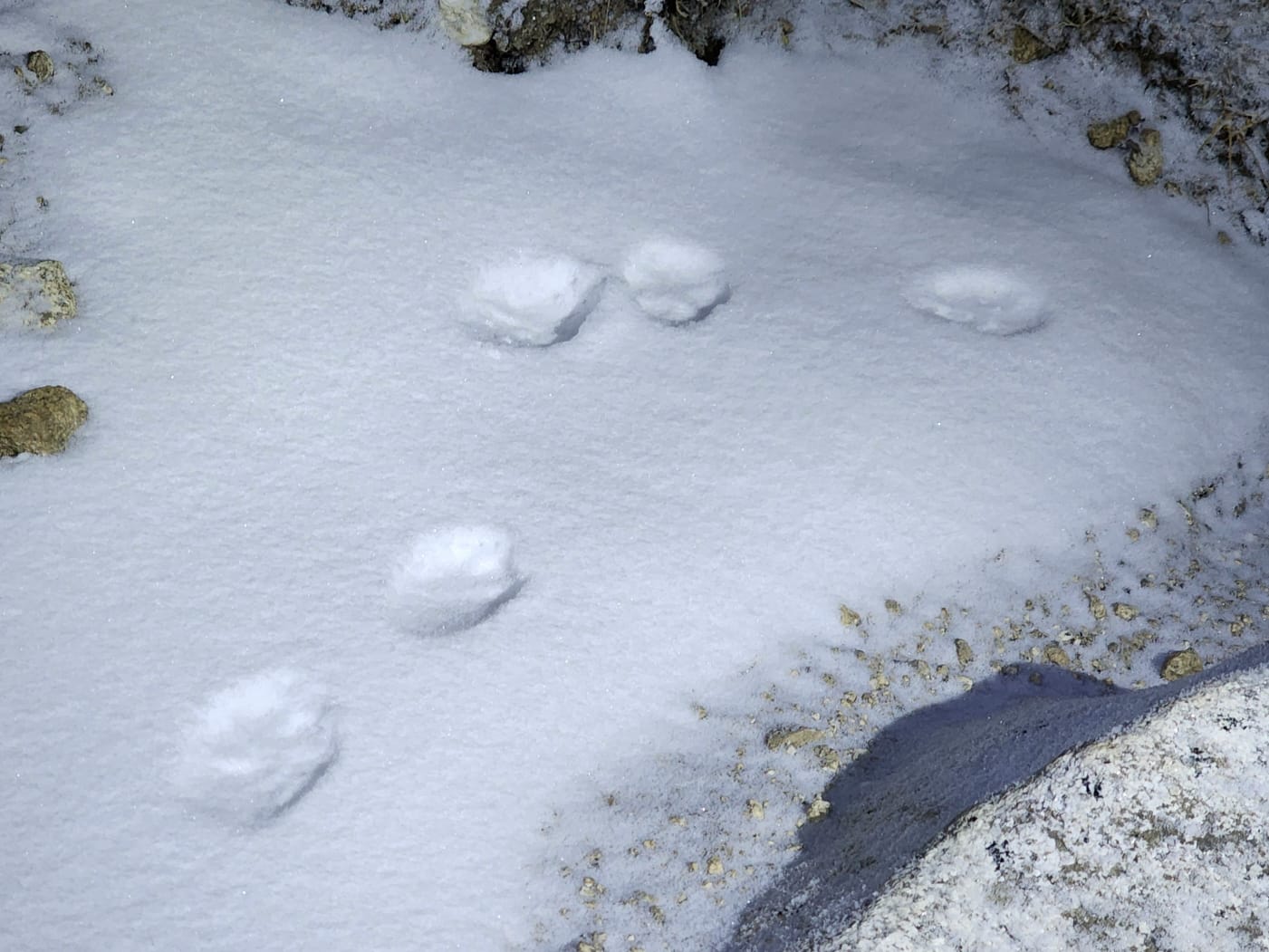
Fresh snow leopard prints?
Not quite half way, an industrious man had set up a tea shop, we were surprised and thrilled in equal measure. We were doing well and keeping ahead of the main group that were just behind us now, but the lure of a cup of hot water was too much. We decided to stop for a little rest and a warm drink and many people went past. But that’s ok, it wasn’t a race. We saw some of the friends we’d made in the dining hall the day before and were glad to see everyone had made it out of camp and on the way. We didn’t get many photos leading up to the pass, it was just too cold to stop and take gloves off.
I must say, that last stretch up to the pass felt like it lasted forever, was definitely a case of how much further, are we there yet. It was incredibly beautiful, just hard work walking in the snow. And then suddenly it was in front of us! We had made it!! So many emotions went through us, joy, excitement, and relief. A huge sense of achievement. We had planned to spend about 15 or 20 minutes here, have a rest and a little snack break. But a strong freezing cold wind was blowing and it was just miserable. We put down our bags, took a photo, put on our crampons, and left lol. Bashu and Nara were so sweet, they had both brought sashes with to give us at the top. We didn’t see anyone else’s guide doing that for them. It was so thoughtful of them and we felt very special. Of course it was an achievement for them as well and we all enjoyed this moment together.
We made it!
I'm the king of the world!!
Celebrating together
Ja no, probably won't see you again Larkya Pass 😄
Initially we thought the way up to the pass would take 5 hours, but after deciding to take it slower thought it might take us longer. But we were bang on 5 hours arriving at the pass at around 08:30 with a couple of rest stops along the way. So that was good, we weren’t as slow as we anticipated. From the pass then it was time to start heading down, eight and a half days of going up and a day and a half to go back down lol. There was a lot of snow on the pass and the way down was really steep. We used snow crampons to help us on the way down, it made it so much easier and we were glad we had some with us! There was some slipping and sliding along the way, Bron landed on her bum once but overall all was fine. After going down a bit we stopped for a snack break, just a quick biscuit and snickers bar and fluid top up and then keep going down. It was cold and cloudy the whole way down, we kept our down jackets on all day.

A little rest break a little bit after the pass.
Thank goodness for snow crampons!
You won't lose me in my red raincoat lol.
From this side of the pass it’s possible to see some of the Annapurna range (on the map shared in the previous post, the Thorong La is the pass of the Annapurna trek) but it was too cloudy to fully appreciate the views. The cloud partly cleared for a brief moment so we could see the lake and glacier but it came in again soon after and settled.
All we saw of the Annapurna range, the glacier, and the lake due to the cloud cover.
It was very atmospheric though.
At some point further down there was a small camp similar to Dharamsala but much better lol. There were some lovely big tables outside and we stopped for a tea break. The ‘teahouse’ in Dharamsala had given us a packed lunch, Justin requested Tibetan bread and jam and Bron two chapatti with an omelette. The jam had been included but not the omelette lol. After quite a long rest break, we continued down to Bhimthang. The teahouse here was made up of individual wooden huts. Even with a long ‘lunch’ break, we still made it down from the pass in the predicted 5 hours to arrive at the accommodation at ~13:30. It was weird to have already done 10 hours of hiking and only be early afternoon. We all checked in, cleaned up and had a well earned nap! We made our way to the dining hall at about 16:30 for some chill time with Bashu and Nara and an early dinner. It was a lovely evening celebrating together. And a super early night of in bed at 19:00, we were all super tired.

A celebratory rum in Bhimthang
The teahouse and wooden cabins in Bhimthang.
Our cabin was further down the back.
This was the second German Shepherd we saw on the trek, he was the goodest boi and sooo fluffy.
And suddenly just like that it was Day 10 and the last day of the trek. We slept well and woke feeling good and not sore after the long pass day and were thankful. Bron had caught some snow burn despite lathering up with sunblock, very red nose and cheeks, the only parts sticking out from under all the layers and sunglasses. And very sore swollen lips, eating and drinking was a real challenge for two days. And we looked very weathered, peeling and crusty for about a week lol.
Today was another 10 hours of hiking downhill to Dharapani. We left early at ~08:00 and bumped into friends from the dining hall in Dharamsala on the way out of the village. We hadn’t seen them while crossing the pass so were glad to bump into them and see that they had made it and were doing well. They were not going as far as Dharapani today so it was unlikely we would see them again on this trip.
The first half of the day was incredibly steep going down but kept a good pace. Bron had been trailing at the back for 9 days, today she was up front keeping pace with Nara our pace setter. We said goodbye to the yaks and entered back into the tree zone and walked through beautiful flowering rhododendrons again. A lovely tea break with more mountain views and a pack of mules. A herd of goats bleating on the way out and we were on the way again.
Today was predominantly downhill but there were a few patches of going up, our overall climbs up today was 500 m, was not expecting that. There were quite a few hikers going in the opposite direction approaching the Larkya La from the Annapurna side. Oh my goodness, what a tough time, this climb must have been awful going this way. Please don’t go up this way!!
Views on the walk from Bhimthang to Tilije
At a certain point we reached the gravel road and walked for an hour before reaching the village of Tilije where we stopped for lunch. We were the only ones there and Bashu invited us into the kitchen. It’s the first time we were allowed into a teahouse kitchen, usually clients are not supposed to go into the kitchen. And what a kitchen it was! Large, well equipped and super organised, we all had kitchen envy.
The loveliest teahouse kitchen.
We all had serious kitchen envy!
Our meal in preparation.
I loved these gas stove top pressure cookers for cooking rice.
Bron's fresh veg noodle soup and omelet
Justin's fried spring rolls
We left lunch together with a group of mules and one straggler walked at the back of his group with us. Another two hours of walking on the gravel road and we made it to Dharapani. Sadly a huge storm and flash flooding a few years ago washed away the newly built bridge and hotel.
We made it! We were at the end of the trek! It was such a wonderful feeling and hard to believe at the same time. And finally a hot shower! Well luke warm, but hey, no complaints. And we had our own little bathroom with a sitting toilet! Much happiness lol. A very chilled evening and early night followed. Dharapani is also early on in the route of the Annapurna Trek, day 3 or so. There was a fair size group doing the Annapurna Trek staying at the same teahouse. We were pleased we were at the end of our trek and though of all the things ahead of them.
The last stretch to Dharapani on gravel road with a mule for company
Dharapani is just on the other side of this river
Joy and relief at the end of the trek.
We walked 25 km downhill today. We were expecting it to take ~10 hours but in the end did it in 8 hours including a 30 min tea break and an hour lunch, so effectively the walking time as ~6.5 hours, not bad after all the hiking of the last 9 days! The whole trek we woke up feeling good and not sore at all. After this downhill day our shins and thighs were a bit sore and a long day sitting in the car and not really moving probably didn't help. But we were fine the following day.
The next day was a long drive day back into the city. We expected the road to be a bit better than on the way to Machha Khola but it was not. The initial gravel road eventually gave way to a tarred road of varying quality and increasing traffic as we got closer to the city. We had 3 very short stops for a restroom break, lunch (30 min tops), and a final restroom and coffee break. After the coffee stop, there was suddenly a long queue of cars in front of us. Apparently this is a regular occurrence and the police were checking the papers of every car and was just a corrupt scheme to elicit bribes. It could take 3 hours to get through this check point so the driver took us on a hair raising shortcut but it worked, we missed the checkpoint and were back on the same road leading to the city. It was slow going with lots of trucks and we hit bad traffic on the outskirts of Kathmandu due to roadworks. We were expecting today to be 8 hours of driving but in the end was 10 hours. We all had a nap at some point and were very over it by the time we actually arrived.
An impressive waterfall just outside of Dharapani
We ended the day with a lovely final celebratory and farewell dinner with Bashu and Nara before they departed for home and to meet their families after a long 12 days away.
A celebratory and farewell dinner in Bhaktapur
Thank you Bashu, Nara, and all at Snow Cat Travel for an amazing time and taking good care of us! Justin is already planning the next trek, Bron needs a day lol.
See you next time for more on our adventures in Bhaktapur and last two days in Nepal!
Take me back to the mountains

